At Mohd Mahd’s restaurant, the poet, philosopher, food scientist, and chef serves lessons in the art and science of hospitality.
Old School
keepsitcommerci a l -

By Mike Sula,p.4
THIS WEEK
FOOD & DRINK
04 Feature | Sula Old School serves surprising hospitality lessons.
NEWS & POLITICS
08 Surveillance Aesthetics | Caporale The Internet is ruining sex.
ARTS & CULTURE
09 Review A Rockford native finds resonance in Belt Publishing’s new anthology.
10 Review Yasmin Spiro creates a psychic landscape of Jamaica at the Hyde Park Art Center.
11 Art of Note Faye Yingfei Liang searches for the truth among tragedy, “NEPO” honors the art of friendship, and Faisal Anwar illuminates Earth’s hidden elements.
THEATER
12 Plays of Note Chicago at Redtwist is a comic delight; Theatre Y’s latest ambulatory show, In Good Company, provides space for community ritual and reflection; Paranormal Activity brings horror-movie tropes onstage at Chicago Shakespeare; and more.
FILM
16 Movies of Note Guillermo del Toro’s Frankenstein is a love letter to his greatest influence; Kathryn Bigelow’s A House of Dynamite fails to explode.
17 Moviegoer Schlock and awe
MUSIC & NIGHTLIFE
18 Feature | Galil J.T. IV’s wild horror trash joins the Blu-ray canon.
20 Chicagoans of Note | Galil Dewey Burtker, hardcore-scene artist and musician
22 Shows of Note Previews of concerts including G Herbo, Electric Citizen, and Lexa Gates
26 Gossip Wolf | Galil Indie rockers Cusp celebrate their first album as a fully functional fivepiece, the CheckOut hosts a live-scored screening of Häxan, and more.
BACK
25 Savage Love Approaching difficult conversations with your partner
26 Jobs
Services
Matches
(Clockwise from top le ) From the exhibition “Cornerstone,” featuring the work of Yasmin Spiro at Hyde Park Arts Center
MOSHER SHIRA FRIEDMAN-PARKS Still from J.T. IV’s Cannibal Orgy (1985)

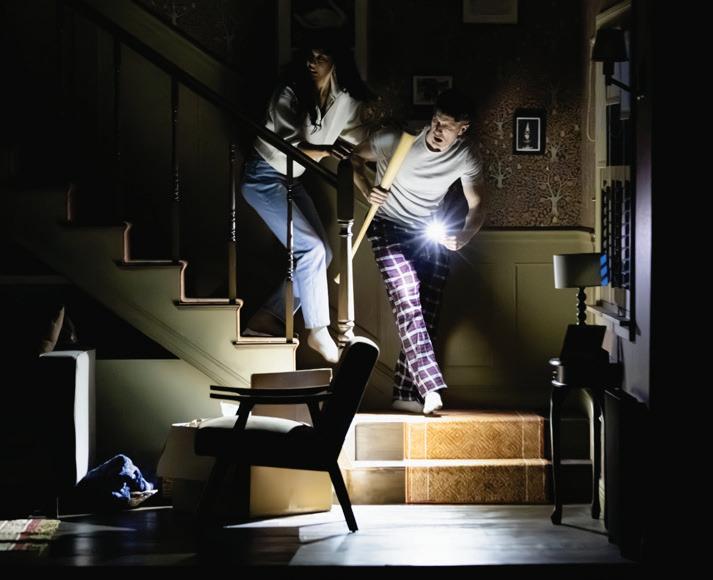
CHICAGO READER | OCTOBER 23, 2025 |



INTERIM PUBLISHER ROB CROCKER
DIRECTOR OF ADVERTISING AND REVENUE
PRODUCTS AMBER NETTLES CHIEF OF STAFF ELLEN KAULIG
ASSISTANT MANAGING EDITOR
SAVANNAH RAY HUGUELEY
PRODUCTION MANAGER AND STAFF
PHOTOGRAPHER KIRK WILLIAMSON
SENIOR GRAPHIC DESIGNER AMBER HUFF
GRAPHIC DESIGNER AND PHOTO RESEARCHER SHIRA
FRIEDMAN-PARKS
THEATER AND DANCE EDITOR KERRY REID
MUSIC EDITOR PHILIP MONTORO
CULTURE EDITOR: FILM, MEDIA, FOOD AND DRINK TARYN MCFADDEN
CULTURE EDITOR: ART, ARCHITECTURE, BOOKS KERRY CARDOZA
NEWS EDITOR SHAWN MULCAHY PROJECTS EDITOR JAMIE LUDWIG
DIGITAL EDITOR TYRA NICOLE TRICHE SENIOR WRITERS LEOR GALIL, MIKE SULA FEATURES WRITER KATIE PROUT
SOCIAL JUSTICE REPORTER DEVYN-MARSHALL BROWN (DMB)
STAFF WRITER MICCO CAPORALE
SOCIAL MEDIA ENGAGEMENT
ASSOCIATE CHARLI RENKEN
VICE PRESIDENT OF PEOPLE AND CULTURE ALIA GRAHAM
DEVELOPMENT MANAGER JOEY MANDEVILLE
DATA ASSOCIATE TATIANA PEREZ
MARKETING MANAGER MAJA STACHNIK
MARKETING ASSOCIATE MICHAEL THOMPSON
SALES REPRESENTATIVE WILL ROGERS
SALES REPRESENTATIVE KELLY BRAUN
SALES REPRESENTATIVE VANESSA FLEMING
ADVERTISING
ADS@CHICAGOREADER.COM, 312-392-2970
CREATE A CLASSIFIED AD LISTING AT CLASSIFIEDS.CHICAGOREADER.COM
DISTRIBUTION CONCERNS
DISTRIBUTIONISSUES@CHICAGOREADER.COM
READER INSTITUTE FOR COMMUNITY JOURNALISM, INC.
CHAIRPERSON EILEEN RHODES
TREASURER TIMO MARTINEZ
SECRETARY TORRENCE GARDNER
DIRECTORS MONIQUE BRINKMAN-HILL, JULIETTE BUFORD, DANIEL DEVER, MATT DOUBLEDAY, JAKE MIKVA, ROBERT REITER, MARILYNN RUBIO, CHRISTINA CRAWFORD STEED
READER (ISSN 1096-6919) IS PUBLISHED WEEKLY BY THE READER INSTITUTE FOR COMMUNITY JOURNALISM 2930 S. MICHIGAN, SUITE 102 CHICAGO, IL 60616, 312-3922934, CHICAGOREADER.COM
COPYRIGHT © 2025 CHICAGO READER ALL RIGHTS RESERVED. CHICAGO READER, READER, AND REVERSED R: REGISTERED TRADEMARKS ® TO CONTACT ANY READER EMPLOYEE, EMAIL: (FIRST INITIAL)(LAST NAME) @CHICAGOREADER.COM










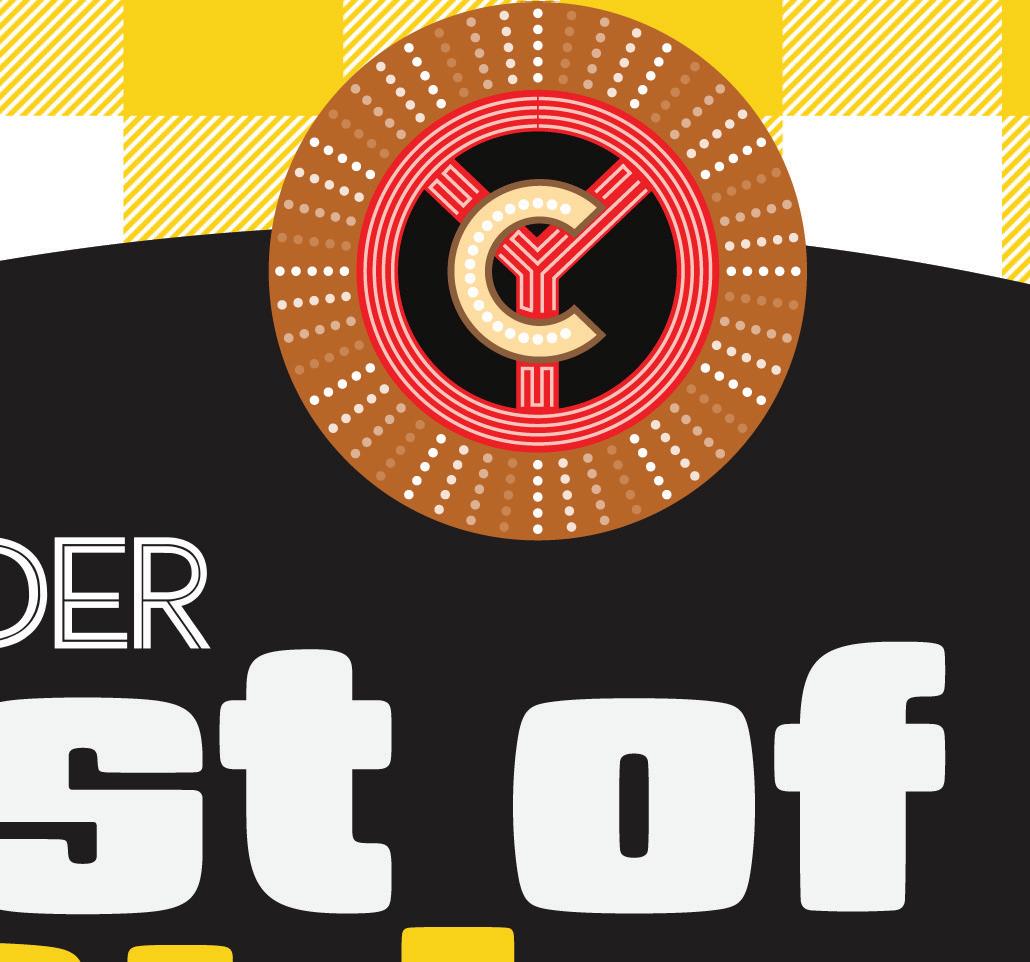








FOOD & DRINK

At Old School, Mohd Mahd offers his guests a guarantee: “If you need a knife to cut the meat, you’re getting the food for free.”
That applies to the all the tender, slowcooked lamb dishes in his rotation—the roasted shoulders, necks, and heads; the kufta, ouzi, mandi, and maqloubah; the polarizing qidreh, the rice-stu ed innards, the sweetbreads, and especially the whole roasted animals he prepares for special catering orders.
Amid the dozens and dozens of Middle Eastern restaurants operating in the southwestern suburbs surrounding Old School, none serve anything like Mahd’s food. It’s religiously scratch-made to exacting specifications. He
RESTAURANT FEATURE
Old School keeps it commercial-free
At Mohd Mahd’s restaurant, the poet, philosopher, food scientist, and chef serves lessons in the art and science of hospitality.
By MIKE SULA

renders his own fat, simmers his own stock, hand-stuffs his own sausage, and mixes his own unique spice blends and hot sauces.
But the word “restaurant” doesn’t do justice to the unique enterprise he’s run for the past eight and a half years out of a small Palos Hills strip mall storefront. He’d probably also disagree with the word “enterprise,” since he operates with a zealously anti-commercial ethos. He has no set menu. His website, which displays photographs of almost two dozen dishes out of a repertoire of too many to count, is out of date, and he plans to take it o ine. He and his sta of five—including two sons—do not accept tips. “I don’t want my kids to be motivated by money,” he says. “I want them to
be motivated by the pleasure they see on our guests’ faces.”
And he offers visitors another unconventional guarantee: “I tell each and every guest of mine that I plan to enjoy every penny of your money in return for you enjoying every bite of my food. There is no universal standard of taste. Everybody has a di erent palate. So try my food. If you didn’t like it, share a feedback with me. I’ll be very happy. I’ll learn from it, but I’ll refund you right away. You have till 1 AM every day to send me a text message.”
He says that’s only happened about eight times since he’s been open and only with one particular dish, which now he gatekeeps, depending on your country of origin. It’s

the qidreh: chunks of bone-in lamb and rice cooked in lamb fat and ghee, with chickpeas, and a heroic amount of garlic. He usually uses basmati rice unless you’re from Hebron, a city in the West Bank where most scholars believe qidreh originated; in that case he uses short grain rice.
“It’s a very, very Middle Eastern dish, and I o ered it to people whose palates were never prepared to receive it. That is a taste that targets a particular palate. Even in the Middle East, it will be surprising. If you go to Hebron, if you go to Gaza, if you go to parts of Egypt, they’re familiar with that taste. But for all the others it cannot be universalized. It would take them by surprise.”
FOOD & DRINK

Last Sunday he served it to me and my group of five during a long, lazy afternoon lunch that also featured six more lamb dishes, many of them served over heaping piles of rice that were each seasoned differently—some saffron-colored, others cooked with sweet dried cranberry and plums. The centerpiece was a whole roasted lamb head peeking out from a wreath of fried “innards.”
Those aren’t as gutsy as they sound. They’re veal casings stu ed with rice and minced lamb that go by many names across the Middle East. Mahd calls the dish masareen, as they do in Jerusalem, where his parents were born. But sometimes he refers to it as “the Arabic hot dog.”
The meal also featured four hot sauces (three of his own invention), yogurt, pita bread, a thin flatbread called fallahi, sweet tea, energy drinks, a minced vegetable salad (for a pretense of balance), and a large sheet of freshly made knafeh: melty white Nabulsi cheese topped with crispy shredded phyllo dough and drenched in syrup and ghee, which he ordered from Selma’s, the sweet shop behind the restaurant. This doesn’t include two smaller samples of masareen he brought out, one cooked in yogurt and another in lamb stock, and a piece of intensely seasoned roast chicken.
“I don’t think highly of chicken,” he says. Still, he makes plenty of it, as well as beef and veal dishes by special order.
Everything was delicious; rich, homey, and saturated with soul. As promised, the lamb fell apart to the touch, no knives required. It could be eaten just scooped up with spoons. No one had a single complaint. Even so, at the end of this four-hour feast Mahd adamantly refused to accept payment. When I protested, he stood his ground.
“Ethics come to work,” he said as he sent us on our way, loaded with leftovers. “This is friendly. Did you pick anything? Everything? No, you didn’t. I picked everything. If you pick anything, you pay for it. But you didn’t.”
Mahd doesn’t go all-out like this for everyone, or even every day. Depending on how much catering he has scheduled, he goes into work, sometimes as early as 1 AM, without any idea of what he’s planning to make that day. He drinks his co ee—totaling about ten cups a day—and decides on a minimum of five dishes, none the same as the day before, except maybe variations of the labor-intensive masareen, his signature Old School lamb shoulder, and some kind of chicken dish. What he cooks each day is what you get when you walk through the door. What you can depend on getting each day is a generous helping of Mahd’s distinctive
brand of hospitality.
“I’m not exactly a businessman,” he says. “I treat my business as an extension of my family. If somebody eats at my place, I would definitely, and with honor, take them into my very own house. The commercial idea of advertisement and trying to lure customers into my business is something that goes against the very principles I stand for.”
Earlier this month I spent a few hours at Old School listening to Mahd’s life story while using a plastic spoon to shovel mouthfuls of rice and his incomparable lamb shoulder, seasoned with a heady blend of ground fenugreek, turmeric, cardamom, coriander, sweet clover, and chamomile, its aroma preceding it out of the kitchen. Mahd was born 54 years ago in Amman, Jordan, and bears a striking resemblance to the late Hollywood character actor William Hickey: his looks, his mannerisms, but also his gravelly voice—a stentorian bass relative to the Oscar-nominated thespian’s quavering, cigarette-scraped rasp. When Mahd speaks it’s impossible not to listen.
When he was an infant his family moved to the U.S., where he spent his first six years while his father earned a PhD in nuclear physics at Stanford. Back in Jordan, he excelled in school, despite some teachers and students mocking his distinctive voice. Eventually, he went to the University of Jordan where he studied food science and nutrition.
“I graduated from college, and I learned the value of freethinking,” he says. “An agenda and freethinking don’t go hand in hand. If you’re a truth seeker, you cannot have an agenda. Your agenda could change once you find the truth.”
After a short career working as a procurement and kitchen manager for a large corporation that owned licenses to operate American fast-food brands, he landed in Chicago in 1996. He worked in restaurants and drove cabs, occasionally receiving o ers for voiceover work from riders. He always turned them down. “My voice was the only thing they were interested in,” he says. “We didn’t have any kind of conversation about what else I had to o er. I thought it was dehumanizing.”
He found a more e ective use for his voice


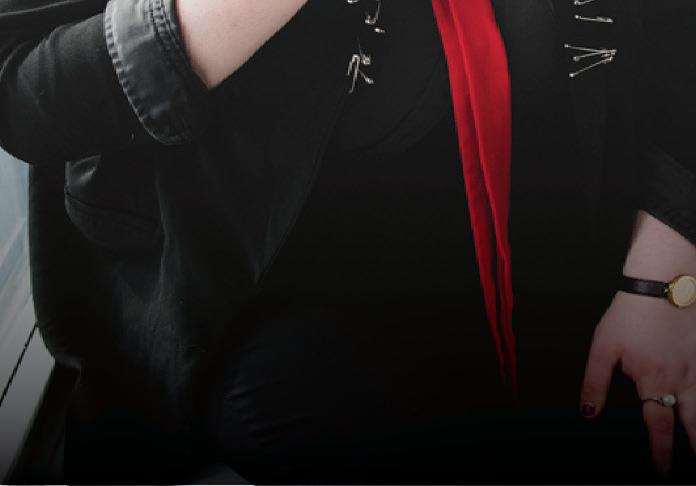





Get your dose of Chicago’s best with the latest news in food and drink every Friday. It includes everything you need to know about Monday Night Foodball, our weekly chef’s pop-up!







FOOD & DRINK
continued from p. 5
performing at the Green Mill’s storied Uptown Poetry Slam in the early 2000s. “When I was young, I loved languages and poetry,” he says. “Just like painting, it allows you to express feelings otherwise impossible.” He rattles o long passages from Robert Burns and Shakespeare as well as the words to Norwegian pop star Janny Loseth’s 1977 hit “I Wished I Was a Poet,” all of which he says changed his life in various ways.
That’s not all he can recite. I’d eaten at Old School twice over the last year before giving Mahd a call. When I introduced myself as a reporter, he immediately began quoting media theorist Marshall McLuhan and cultural critic Neal Postman, the latter whose books Amusing Ourselves to Death and The End of Education inspired him to pursue a master’s degree in media theory at Northern Illinois University in 2007.
That was preceded by short stints at UIC (food process engineering) and IIT (industrial technology and management). In the end, he chose not to complete any of the graduate programs, explaining all three schools left him feeling limited in his ability to pursue truth. But his studies at NIU, particularly the work of Postman and psychotherapist Alfred Adler, inspired him to homeschool his children, of which there are now eight.
“I couldn’t a ord a decent school district,” he says. “So I decided on homeschooling my children. As a typical Middle Eastern man, I wanted my children to grow and think in my general direction. Do you know how hard it was to prepare myself for the idea that my job is to equip my children with the necessary tools, vocabularies, and mathematical knowledge to allow them to critically think? I came to tell my children that every statement that gets out of your mouth has to be treated like a doctoral thesis that you are defending. Most importantly, it has to be defended in front of yourself.
“I thought a small family business would allow me more time with my kids. I’ll teach them chemistry while I’m cooking. I’ll teach them fun while they’re cooking. I’ll see them interacting with a wide array of people. I used to take them to Lifetime Fitness and, when they grew a bit older, to the gun range, because they like shooting; or riding horses or going to the farmland. I didn’t treat it like a business. I treated it as a complementary faculty.”
Mahd named his business Old School for “the school of thought that is based on a
human dealing with a human, not a vendor dealing with a customer. They’re guests, not customers.
Mahd first learned to cook primarily by observing his mother. As a parent of eight, he says she cooked out of necessity, but with her
“A heart can never be hired.”
then stu s them with rice mixed with onions, garlic, parsley, mint, and spices.
Whether they’re picking up an order or dining at one of Old School’s four four-tops, Mahd seems to know everybody who walks through the door, greeting each with an easy handshake and a brisk “assalamu alaykum.”
heart. She didn’t use recipes, and neither does he. “When you’re dealing with natural products, you cannot have an exact recipe,” he says. “Each cut of meat will tell you how much salt to put in. It will tell you how much black pepper, how much ginger, how much coriander.”
“There are only two ways to look at food,” he continues. “Either you look at it as a necessity—and that removes the fun and the art of it. Or you look at it as poetry. The ingredients are the alphabet. You put ingredients together; you’re making the words. Which words you put together may give you the rhythm. Once you catch that, you will become a poet.”
He didn’t put up an “open” sign for a year. “Anybody who walks in, they will ask me, ‘What are you selling here?’ I’ll tell them, ‘Oh, we offer tea, a little conversation, and you try our food.’ It took several months before the name got out. I grew organically. The busiest day in the first few months was, on average, maybe 19 to 29 customers. So I got to know them by name, and I got to learn from their experiences.”
“I use food as a medium of communication, as a way to talk to people as people. This is a universal need in human society. I present them with something that is done with heart. That’s the reason I don’t have a menu, and I never will. I tell my guests, ‘The moment I have a menu is the moment you should stop coming by.’”
He doesn’t do it often anymore, but in the past Mahd posted what he was making on his Facebook page, usually preceded by an arti-
idea here that we’re genuine. We don’t imitate anybody. The market and the forces of supply and demand are not our master, not our coach, not our guide.”
Last Sunday, as we ate lunch a guest came in to pick up two orders of Old School lamb shoulder. He tried to leave a $25 dollar tip, but Mahd chased him into the parking lot and returned the cash. In the unlikely event that he ever decided to operate Old School as a more traditional restaurant with a regular menu, he would make other changes, like blocking Internet access and installing the collection of two thousand-some books he keeps at home.
This is a piece of his dream: to open another, more ambitious place in a quieter, less carswept area with trees: a two-floor restaurant that could house his library, where he would o er a prepaid seven-course meal that chang-


“There
He spends a long time interviewing his catering customers on their background and preferences. If they come from green, verdant places he incorporates fresh yogurt in some dishes. If they come from arid, desert regions he’ll use the strained, dried, and reconstituted yogurts called kiskh or jameed that they’re accustomed to.

are only two ways to look at food. Either you look at it as a necessity—and that removes the fun and the art of it. Or you look at it as poetry. The ingredients are the alphabet.” KIRK
Iraqis prefer their masareen boiled in yogurt. Syrians, Jordanians, Lebanese, and Palestinians like it boiled and then roasted. Egyptians want it fried. No matter who he’s making it for, he starts by boiling the casings,
cle he’d written intended to encourage open debate. “That’s my repellent. Facebook is the way I try to avoid those who don’t agree to disagree. One of my favorites was about the quality of each human being irrelevant of their genetics or background, or ‘I treat everybody like a VIP except those that call themselves a VIP.’ With these pictures of food, I’m giving an
es daily according to his whims. Of course, there would be no tipping.
“I have no idea how to market it,” he says. “Sticking to this alone is anti-commercial. This cannot be commercialized. A heart can never be hired.” v
m msula@chicagoreader.com


Southeast Spotlight: Mayfair Arts Center
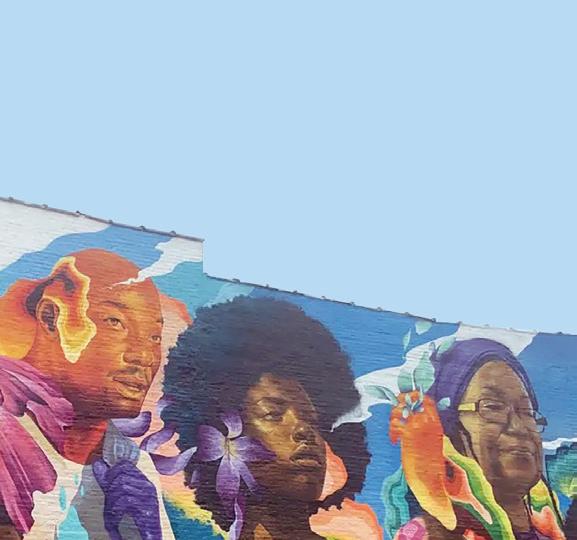



Curious to catch a vibe but unsure how to find the rhythm? Two-steppin’ and grooving to the beat is made accessible for all at the Mayfair Art Center.
The Chicago Human Rhythm Project (CHRP), the originator of one of the world’s oldest tap dance festivals, was founded in 1988 by Lane Alexander and Kelly Michaels. A er years of being housed in the Fine Arts Building on Chicago’s Michigan Avenue, CHRP faced the need for significant change due to the COVID-19 pandemic. So, Alexander innovated and joined forces with fellow dance companies and performing arts organizations to make the move to the southeast side. To honor the legacy of their fellow dance school, the Mayfair Performing Arts Academy—founded in 1957 by Tommy and Amanda Sutton and later stewarded by their daughter Peggy— Alexander and the team kept the name and continue to carry on its inclusive mission.
CHRP houses several staple projects that span iterations of movement across many cultures. Through the
MAYFAIR ARTS CENTER
8701 S. Bennett Avenue
diversification of their work and stewardship of the Mayfair Arts Center, CHRP’s every endeavor perfectly aligns with their goals of generating social and economic justice. Mayfair has become almost like a collective of movement-oriented companies. CHRP, Black Girl Dances, Emma Mae’s SunRays Studios, Deeply Rooted Dance Theater, Russell Talbert Dance Theater, and more all operate inside the walls of Mayfair, but their reach is citywide.
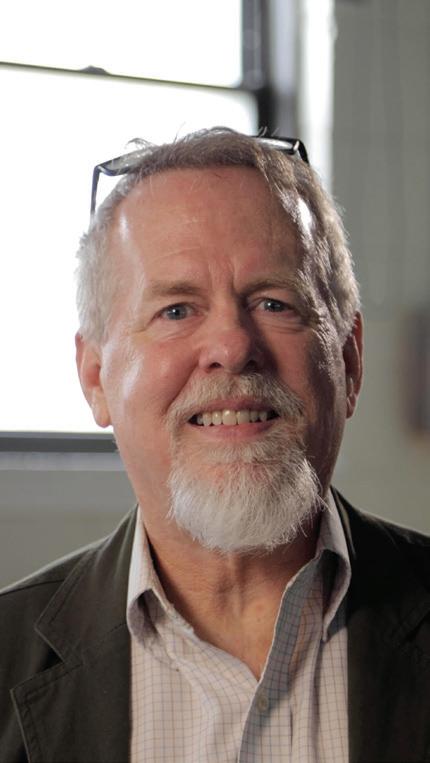
In addition to being a community-centered space for dance and bodily expression, the Mayfair Arts Center also offers space for other organizations to host their meetings and events. Alexander and the team create and uphold space for community development and educational engagement, and the Southeast Chamber of Commerce is proud to host its regular Wine Down Wednesdays and quarterly community meetings at Mayfair. Whether you’re looking to join business-focused programming, host an event of your own, or learn some new moves, Mayfair Arts Center is a caring, experimental space for all.




Monday: 10 AM-8:30 PM; Tuesday and Wednesday: 9 AM-8 PM; Thursday and Friday: 10 AM-8 PM; Saturday: 9 AM-5 PM; Sunday: 11:30 AM-5 PM chicagotap.org | @chicagotap | 312-922-1272 Read the
NEWS & POLITICS
SURVEILLANCE AESTHETICS
The internet is ruining sex
What the lack of privacy means for intimacy in the digital age
By MICCO CAPORALE
Nothing has changed cultural ideas about sex and privacy quite like the Internet. How the algorithm rewards conflict, coupled with failed models of o ine accountability, has encouraged a digital culture of surveillance, especially as it relates to bedroom behavior. This was the focus of a discussion at Pilsen Community Books on October 1. To promote the latest issue of socialist feminist magazine Lux , editorial assistant Asya Sağnak sat with contributors Kate Wagner and Carta Monir, a cultural critic and performance artist, respectively, to talk about sex and surveillance.
In her essay “Bringing Sexy Back,” Wagner gets at how the stakes are higher in digital-age sexual relationships, so they invite more pain and scrutiny. But hurt itself is not evidence of harm. She writes, “Punishing strangers for their perceived perversion is a form of compensation for a process that is already completed: the erosion of erotic and emotional privacy through internet-driven surveillance practices, practices we have since turned inward on ourselves.”
To her, on one end of this problem’s spectrum are the manosphere of chuds perpetuating a culture of misogyny and fear rooted in practices such as revenge porn and artificial intelligence deepfakes. But on the other are people who delight in circulating or dissecting so-called evidence—photos, videos, and the like—of sexual transgressions that is designed to invite ridicule. Isn’t my ex crazy? Wasn’t this Tinder interaction cringe? Look at this thirsty bitch I encountered in the wild. Small, private moments of human folly or misunderstanding become large-scale public fodder. What does repeatedly witnessing this behavior teach us to internalize about sex, desire, and vulnerability?
Her point resonated with me. The first time I read the article, my mind kept replaying an experience I had some years ago, very early in transition. I had begun to notice that I repeatedly attracted a certain kind of man with latent, unresolved homosexual desires who would become preoccupied with me without understanding why. One such
man had gotten drunk and sent me a very sexually harassing message. I disclosed this to a friend further along in transition, hoping to experience camaraderie or compare notes about navigating these kinds of interactions. Instead, they quickly changed the subject.
A week later, I got a message from that friend asking if I wanted the man kicked out of his band. I was stunned. They hadn’t asked me any questions about what happened, including how I handled it (extremely cruelly, as I too often do). What did kicking him out have to do with anything? He can’t make music anymore
respond by choosing a villain—though in her case, she was labeled the bad one. When she described being sexually aroused by a haircut, her friend villainized her for eroticizing the hairdresser without the hairdresser’s knowledge and consent. She didn’t act on the thought, but to her friend, simply having it was a violation requiring some kind of penance. Their friendship did not last, much like my friendship with the person who o ered to eject a man from his band for getting drunk and mildly sexually harassing me one time. Cultural anxiety about sex is growing, and it’s

because one time he got too drunk and told a trans person how badly he wanted to fuck them? Was the man going to know why he was kicked out? If so, how was the friend going to protect me from blowback? None of it made sense to me. All I wanted was my friend to be emotionally present for my experience, but they could only conceive of support through action—specifically, action that indicated zero tolerance for sexual harassment. Even one time was too many.
Wagner begins her piece with a similar story about wanting to emotionally parse a sexual experience with a friend who could only
interpersonally underdeveloped as leading causes. Could a culture of social surveillance be a contributing factor, too?
At the bookstore, Wagner and Monir spent an hour sharing how their experiences shaped them. Wagner noted an online tendency toward a fear of being wrong and how that manifested in fraught viral debates, like around which identities are allowed to use which labels, especially as they relate to articulating gender and desire. Monir noted that the Internet, by design, is an aggregation of lists; to “correctly” classify something not only makes it more searchable but also lets the people hoping to be most visible self-police how they’re seen, without questioning or even the act of labeling itself.
“There’s a real temptation to treat identity like a math problem,” Monir said. “It becomes, like, ‘Well, if A, then B.’ So it’s like, if I am a lesbian, then I am a woman. And, you know, if I am a trans woman, then I am not a faggot. . . . Like, anyone who falls outside the woman category could not possibly be a lesbian; there must be a di erent taxonomy for that concept. It feels . . . like we are trying to solve a set of problems that have been created by a culture of categorization.”
especially a ecting younger people. According to Scientific American, between 2009 and 2018, the proportion of adolescents reporting no sexual activity, either alone or with partners, rose from 28.8 percent to 44.2 percent among young men and from 49.5 percent to 74 percent among young women. While correlation doesn’t prove causation, there’s a parallel between the availability of home Internet, the explosion of social media, and the decline in sexual behavior. In 2023, an LA Times article headlined “A ‘failure to launch’” examined why younger people are having less sex, looking specifically at being overcommitted and
Wagner and Monir repeatedly circled back to a pervasive culture of bad faith. And why not? Social media companies and similar digital actors keep us engaged with their platforms by rewarding performances of outrage. The duo also observed a community-wide lack of conflict resolution and interpersonal communication skills when it comes to advocating for our needs and negotiating our desires. This is something Monir is especially versed in: She’s one of the most hypervisible online sex workers making art about BDSM, power, consent, identity, and disability. A through line is the way she feels she lives in truth and integrity, despite how messy and complicated her work—and, by extension, she—can seem on the surface.
As the talk neared its close, Wagner said, “We have a whole culture that is about denying ourselves pleasure in many di erent ways. . . . Like the wellness industry—it’s really about taking things away [or buying products] to make ourselves better.”
“We live under capitalism,” Monir added. “Capitalism is a bootstrap-ass culture where everything has to be about some form of self-sacrifice. I feel like sex for me is a way to escape that. . . . Love is communism.” v
m mcaporale@chicagoreader.com
Rby Rachel León
More than an overlooked midwestern city
The essays in The Rockford Anthology create a rich and poignant telling of the city.
By SARA VERSTYNEN
Rockford, Illinois, and I have ghosted each other for decades, but we refuse to quit each other completely. I grew up there but left after high school, returning occasionally to visit my family, who continued to reside among the strip malls, manufacturing plants, and my former teenage angst. Throughout, my mother continued to insist the city was better than ever, but I rejected her claims. Years
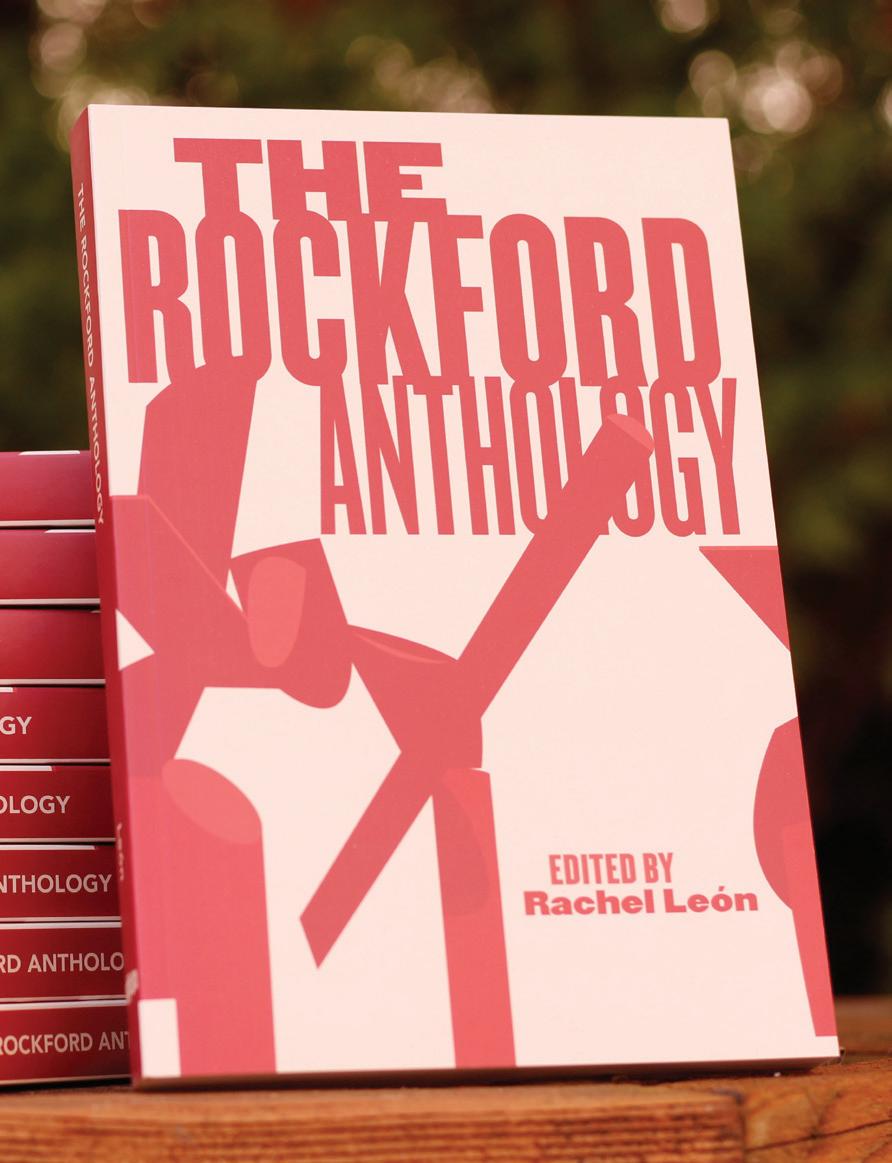
passed, and my dad died. More years passed. My mom died too. Now, Rockford is still the place I left behind, and while I’m still hesitant to believe it’s better than ever, it’s where I return when I want to remember the early life that shaped me.
To visit, my children and I drive west and a little north from our home in Chicago. We inch past the suburbs, out to where the tra c thins, and we catch views of open space and an occasional farm. Eventually, we ease onto the ramp
that takes us to East Riverside Boulevard, past the hospital where my mom died, the one we’ve since tagged “The Scene of the Crime.” We head toward my sister’s home, where she is raising her family in the house where we grew up, near the gum factory. The kids ask about the landscape: where I hung out with friends, what I did with my time. For years, I’ve asked myself similar questions. What did I do in Rockford? What did Rockford do to me?
In The Rockford Anthology, the latest in Belt Publishing’s City Anthology series, editor Rachel León has compiled photographs, essays, and poems that o er a vantage point from which a reader can begin to understand how a place, and more specifically an often overlooked midwestern city, can shape, heal, break, and provide for its residents in surprising and lasting ways. [Disclaimer: The editor and I are both on sta at the online literary journal Arcturus but we do not work together directly.] As I read, I kept returning to urbanist Jane Jacobs’s idea that “cities have the capability of providing something for everybody, only because, and only when, they are created by everybody.” The pieces within the anthology create a rich and poignant telling of a city that, for many, resembles the city of Jacobs’s writings. In fact, León suggests in the book’s introduction that Rockford’s “greatest strength is [its] people.”
How do people in Rockford spend their time? Contributor Purpose Simba, a loctician, left Chicago for Rockford in 2017, hoping to find greater stability and a home where she could get ahead. In her essay, she reflects on how life has improved since arriving in Rockford. It “slowed me all the way down,” she writes. “But I like it. I like peace.” By contrast, Richard Cascio grew up in the area but never quite felt
ARTS & CULTURE
might be skateboarding, a perfect playground for teenage truancy, the public library, a waterfront festival, or a place to heal from injury. Rockford is all of this and more.
at ease. In “You Go East, I’ll Go West,” he o ers honest reflections on how it felt to be a young person there, “sitting on lawn chairs. Drinking beers. Watching the nothing happen . . . .” This resembles the Rockford I experienced. Cascio also notes with generous understanding that Rockford “is still a young city . . . .”
Bing Liu plots a course across many childhood homes where he su ered deeply. While his experience is difficult to read about, the essay maintains a clarity that, when combined with distance and time, reveals a mother’s earnest intentions. When reading Liu’s essay, and so many of the other pieces, one is struck by the way a city can meet a person where they are, carrying them to their next thing. This
Sometimes when I talk about Rockford, it’s hard to describe it accurately. I do, however, remember how it felt to be there, especially as a young adult, on the cusp of leaving. The feeling returns when I come upon Scott Hartman’s photographs of the Jefferson Street Bridge and Uncle Nick’s restaurant. Illuminated and striking, each image transports me into someone’s parents’ car, cruising the streets with my friends, wanting the bridge’s lights to suspend the moment forever.
The story of Rockford is long. It will, of course, change and be changed by the people who live and work and create there. But I sense Rockford will always pulse with an authenticity and groundedness that is specific to itself. I suspect this is why it’s so deeply woven into those who know it and why the collection feels like a portal into a club that will give everyone a shot. v
m letters@chicagoreader.com



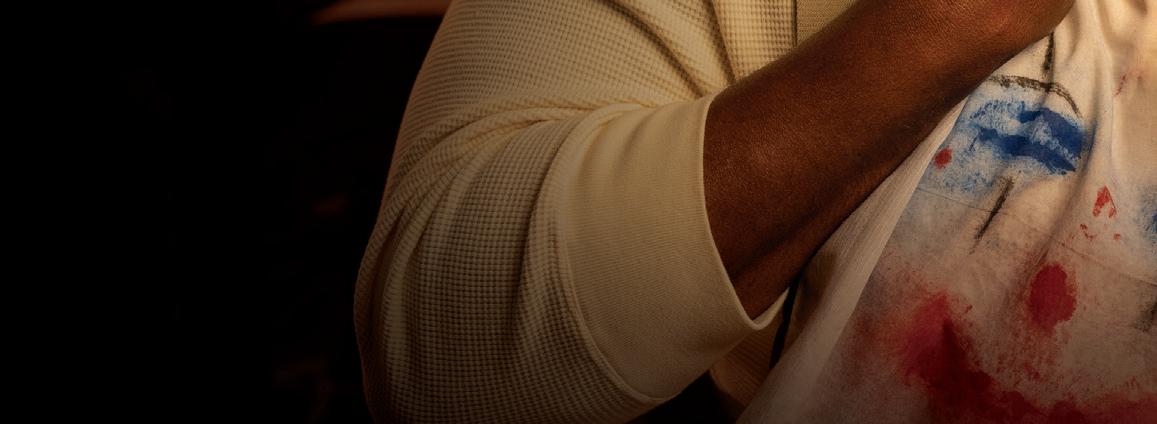

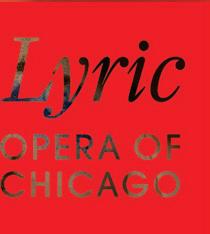
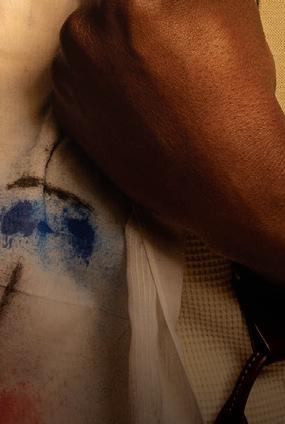
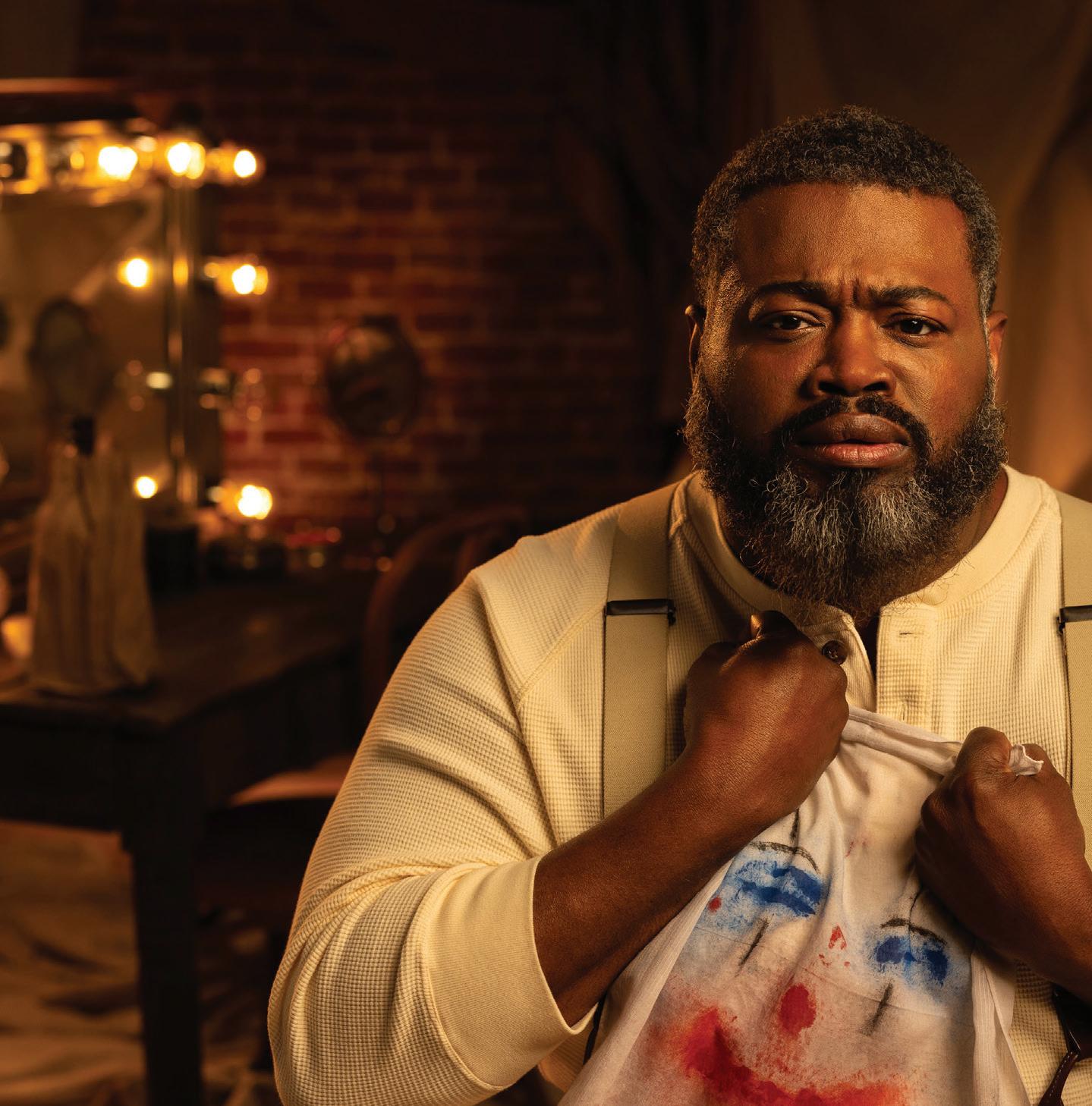
ARTS & CULTURE
REVIEW
Rooted in home
R“Cornerstone” Through 11/2: Mon–Thu 10 AM–7 PM, Fri 10 AM–4:30 PM, Sat 10 AM–4 PM, Sun 11 AM–4 PM Hyde Park Art Center, 5020 S. Cornell, hydeparkart.org/exhibition-archive/yasmin-spiro-cornerstone, free
At Hyde Park Art Center, Yasmin Spiro channels the psychic landscape of Jamaica.
By NATALIE JENKINS
Yasmin Spiro’s work hums with immediacy, rooted as it is in her connection to her homeland of Jamaica. Standing amid the sweeping constructions of “Cornerstone,” the artist’s solo show at the Hyde Park Art Center, a dual awareness arises: a heightened consciousness of your feet on the ground in Chicago in spite of the insistent feeling that you’ve been transported somewhere else entirely.
Cornerstone (Home is a Sound We Carry) , the exhibition’s central installation, stretches upward to the full extent of the lofty gallery. Expansive panels of erosion cloth—loosely woven jute that holds soil and protects plant growth—form walls banked by ceramic tile bases. Unlike typical walls, the boundaries of the work are porous, allowing air and light to flow through. The space they contain is alive with the gentle shifting of the cloth from invisible drafts.
Inside Cornerstone (Home is a Sound We Carry) , the fiber mats provide just enough cover to create a climate of intimacy, o ering a sheltered cove for reflection. Because of Spiro’s use of herbal oils, the faint scent of peppermint emerges, familiar and calming. In this moment of inwardness, a subtle soundtrack becomes remarkably intense. The thrum of cicadas and the cries of tree frogs place us in Spiro’s memories of Jamaica. As we listen, we can’t help but consider the soundscapes of Chicago—ones we take for granted day to day but can vividly recall in their absence. Sound and smell aren’t the only senses Spiro engages to focus attention on the question of home. For her, materiality is central; each element of her work is layered with reference, history, and memory, revealing how our ideas
of home are bound by our relationship to the land and the things we build upon it.
Erosion cloth is common around Jamaica, where climate change and unsustainable
light timber frames covered by thatching, an accessible technique historically common in rural areas of Jamaica.
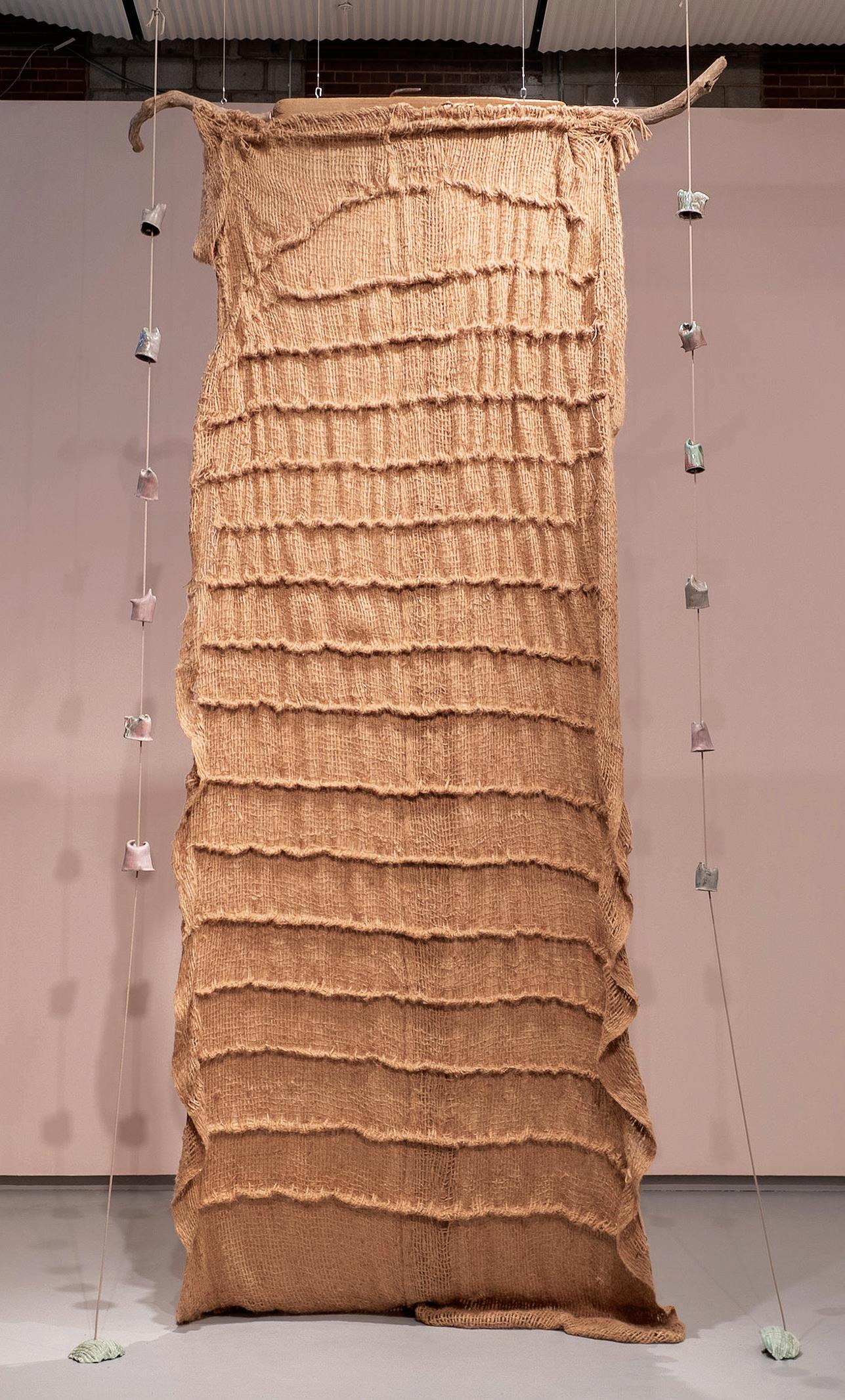
view, “Cornerstone,”
construction have led to coastal erosion. Here, the material evokes vernacular building practices. The looseness of the weave, its vertical presentation, and organic origins recall wooden sca olding, common around Jamaica (and Chicago) due to constant cycles of development and decay. It also conjures images of
Spiro’s Shelter series, installed across an entire wall, is an archipelago of wood, rope, and porcelain. Discrete islands—iterations in the series—are connected by the lazy catenaries of thick ropes suspended between them. The base of each installation is a wooden construction resembling a pallet, which acts as a frame for a woven mat of rope. Adjacent to the weavings are small grids of cast glazed porcelain tiles in muted pinks, browns, and greens.
The ridges of the tiles resemble the form of another material Spiro recalls seeing frequently in Jamaica: corrugated steel. Their varied finishes echo the shifting patinas of metal exposed to time and weather. In each iteration of Shelter, the visual prominence of the ropes foregrounds weaving as a living practice and gestures toward the truth that, for many, the first architects of safety and home are women.
Through material, form, and layered engagement of the senses, Spiro ushers us into a contemplation of place, land, and belonging. As she uses her practice to pay careful attention to the environmental elements composing the psychic landscape of Jamaica, she also conveys a deep longing for rootedness shared by many who live in the United States. Situated in the jumbled strata of history held by land and architecture, “Cornerstone” becomes a porous threshold between places: a shifting, breathing reminder that home is something we continually build, carry, and remake. v
m letters@chicagoreader.com
EXHIBITIONS
R‘No tragedy is irrelevant’ Faye Yingfei Liang and her alter ego search for the truth behind a deadly plane crash.
Spanning both floors of the Cochrane-Woods Art Center at the University of Chicago, “Air Crash Report” begins with a papier-mache sculpture suspended in the lobby. Mimicking burnt and shattered crate fragments, the installation is made with printed reports, documentation, and online speculations around the deadliest plane crash in China’s aviation history.
On March 21, 2022, MU5735 plunged into a hillside in southwestern Guangxi approximately an hour a er taking off, killing all 132 people on board. Previously a photojournalist, artist-curator Faye Yingfei Liang was one of the first reporters to arrive at the scene.
For the next three years, Liang closely followed the investigation, hoping to discover the truth—only to be dismissed by distant official statements claiming the government would strive to prevent a similar tragedy from happening again.
In response to the lack of clarity or closure, Liang created the Crater Surveyor, an alter ego who never stopped searching for the truth.
“The surveyor represents my idealistic self, the reporter who wanted to find the truth,” Liang said. “I want to remind everyone that no tragedy is irrelevant. If one person is not entitled to the truth, then nobody is.”
The Surveyor’s research continues upstairs as online conspiracy theories printed on neon-bright paper greet the visitor in the hall. At the end of the walkway sits the Crater Surveyor’s desk, where printed documents form a massive pillar. Then, the viewer turns to discover Crater Surveyor’s Monologue hidden behind a white curtain.
The video begins with Liang recounting how she followed a villager through a shortcut that was supposed to take her to the crater a er the crash, only to end up almost stranded in the woods. It then shi s into a compilation of IDF attacks on Gaza, footage from 9/11, and documentation of other large-scale violence before returning to a video of MU5735’s final moments.
“We couldn’t stand together, speak out, demand justice, or ask for truth,” the Surveyor says in the background. “We told ourselves it was fine, our lives seemed livable. But you know what? It will eventually devour us.” —XIAO DACUNHA “Air Crash Report” Through 10/31: Mon, Tue, Thu, Fri 8:30 AM–5 PM, Wed 8:30 AM–8 PM, Cochrane-Woods Art Center, 5540 S. Greenwood, vrc.uchicago.edu/air-crash-report
RLove lives here
Amid a flurry of state-sponsored violence, “NEPO” offers a vision of community care.
Chicagoans work hard and tend to their fellowships like gardens. In “NEPO,” curators Tony Lewis and John Schmid share a sorely needed seasonal bouquet of visual art, asking: Is a creative social circle tantamount to an art historical movement? Resoundingly, yes. Friendship and community are not ahistorical or insignificant; rather it is networks of mutual aid and community care that are holding the city together right now. This exhibition opened the same week various federal entities descended upon Chicago, launching a national dialogue about the character of our city. As evidenced here, we are decidedly not a socially disengaged town. This show incidentally opposes the false narrative that Chicago is a dangerous place where people don’t care for or about each other.
The works in “NEPO” playfully banter, acting as avatars for the artists and organizers. An Anish Kapooresque matte black cavity carved into the wall by Nate Young immediately disorients and delights. Kellie Roma-

ny’s wild gestures are rendered in the warm tones of her skin on a commanding 4x4-foot clay board, grounding the room. Bosco Bae’s quiet ceramic vessels appear not of the earth or our era: inanimate objects that are some-
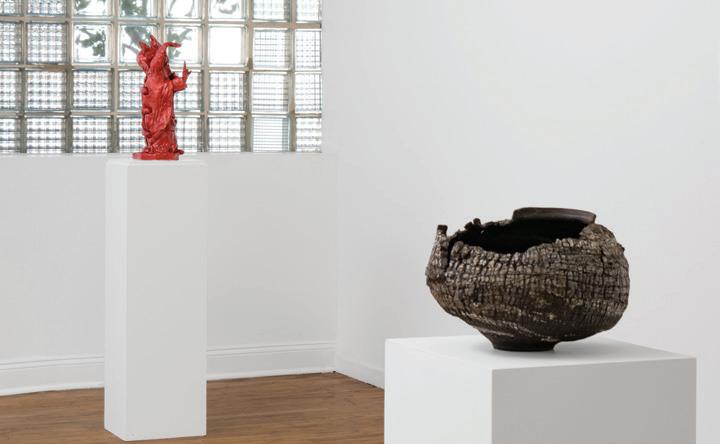



how wise beyond their years. The room hums, echoing decades of discourse between this cast of characters: the architect, the serious one, the troublemaker, the provocateur, the formalist, the jokester, the historian, the one that obsessively documents.
“NEPO” reminded me how complex and miraculous friendships are. It made me think about how many times the people in the room had to forgive each other in order for this show to happen. A er visiting, I drove out to the suburban Broadview ICE facility to observe the dystopian headquarters of state-sponsored cruelty. It was an abrupt transition to go from an offering so deeply rooted in love to witnessing a violent system of structures that only exist because of fear. I wish I could have stayed in the exhibition’s hospitable embrace, considering the relationships that keep us going, the work that gives our lives meaning, and the art we make along the way.
—ERIN TOALE “NEPO” Through 10/31: by appointment only: lewisbagchi@gmail.com, Lewis Bag, instagram.com/lewisbagchi
R‘CommonSky’ reminds us of our interconnectedness
Faisal Anwar dreams dazzlingly with data.
ARTS & CULTURE
presents a landscape of digital prints, interactive installations, and video works, each a portal into the fragility of Earth’s living systems. With calamitous interconnected presents and futures, Anwar dreams dazzlingly with data.
Glowing against the darkened gallery space, works like Azimuth of Time are a poetic synthesis of climate change and movement. Combining ancient knowledge with scientific research, the video projection shifts between Lahore, Chicago, and Manaus and from 1930 to 3035, providing qualitative and quantitative insights into the environment. The projection, the visual outcome of a complex computer program that uses point cloud rendering, can be toggled between times and locations by the viewer, allowing for a chrono-geographical form of travel—simultaneously a disconcerting prediction and a blissful return. As the pulsating rhythmic digital forest looms in all its biodiversity, speculation serves as the evolutionary image of a world caught in its own vortex.
In an era marked by planetary violence, these works unrelentingly draw attention to the imbricated conditions of our terrain. Rather than shying away out of fear of these dire assessments, viewers should take a cue from the exhibition’s title, remembering one binding





THEATER
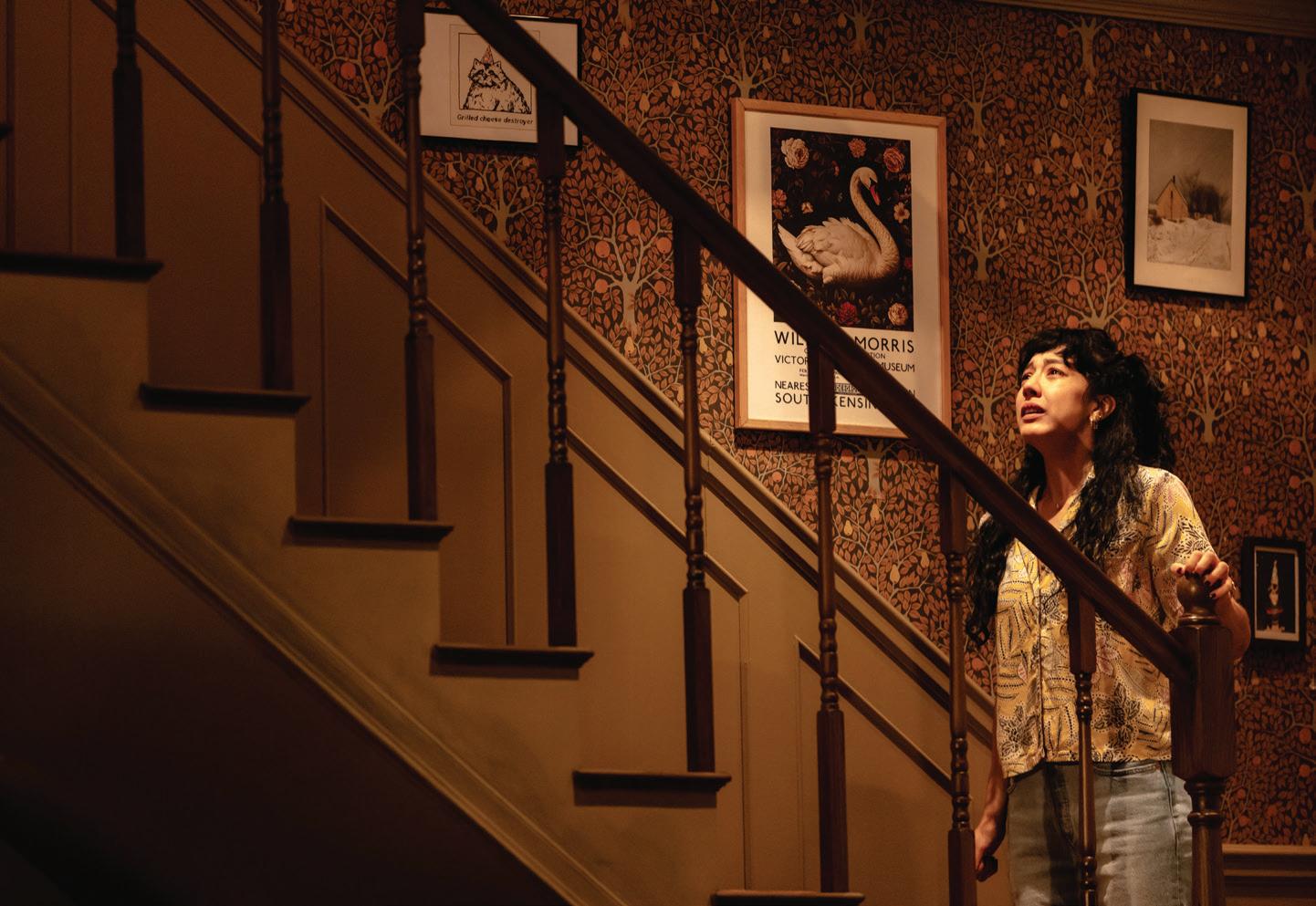
OPENING
RCellblock shenanigans
Redtwist’s reimagined take on the original Chicago is criminally entertaining.
Redtwist originally planned to stage Jen Silverman’s Collective Rage: A Play In 5 Betties When that fell through, public domain came through. Chicago: Queerly Adapted From the Play You’ve Never Heard of That Inspired the Musical You Can’t Get Away From takes Maurine Dallas Watkins’s 1926 play, Chicago, and gives it a splendidly silly makeover, courtesy of adapters Eileen Dixon (who also directs) and Dusty Brown.
Watkins, a reporter for the Tribune, based her satirical comedy on the real-life murder trials of working-class party girl Beulah Annan (the model for Roxie Hart) and socialite Belva Gaertner (the inspiration for Velma)—both of whom were acquitted a er becoming media sensations. The play, as the lengthy title here says, later inspired the 1975 musical by John Kander, Fred Ebb, and Bob Fosse. Watkins’s sardonic send-up of celebrity and corruption (in the courtroom, the jail, and the newsroom) predated Ben Hecht and Charles MacArthur’s classic The Front Page, also about crime and selling newspapers.
Dixon’s spare but smart staging brings in some gender twists that add wry commentary to the ways the women on trial (especially Chelsea Rolfes’s Roxie) play off their pulchritudinous charms and alleged feminine frailties. Roxie’s victim, Fred Casely (with whom she’s having an extramarital affair), and her oily attorney, Billy Flynn, are both played by transmasc actor Jack Seijo. Moe Watkins (a male character named in this version as an homage to the original author) is a hardboiled journalist played by Shaina Toledo, who stands in contrast to simpering “sob sister” columnist Mary Sunshine (Ashley Anderson).
The cast commits to the period style with aplomb without ever wearing out the jokes or going too cartoonish in the small house. Rolfes is a marvel, down to every carefully calibrated quiver of her lower lip, but the sup-
attempts to target “felons, not families,” catches up to Clara when she files her citizenship paperwork: two previous minor convictions for marijuana (at least one of which was already expunged) flag her as worthy of deportation. (This of course reminds us of the people currently being dragged away by ICE from courthouses for the “crime” of trying to become citizens “the right way.”)
Delgado, whose 2017 homage to Chicago Latine nightclub La Havana Madrid became a smash hit for Teatro Vista, has created an intimate and layered look at families caught up in the labyrinthine and deeply unfair and racist laws governing immigration. Clara may not be in quite the same situation as the characters in TimeLine’s 2024 production of Black Sunday by Dolores Díaz, which examined the forced repatriation of Mexican workers in the western United States during the Depression. But as a soul-searing monologue by Clara makes clear, she’s as “American” (and Chicagoan) as can be, right down to her love of OG house music and her “high-level anxiety.” If only the law saw it that way.
home to North Lawndale.
porting cast throughout is exceptional, from JT Nagle’s clueless cuckold Amos Hart to Caroline Kidwell doing triple duty as smarmy assistant state’s attorney Harrison, mentally unstable inmate Liz, and defiant “Go-to-Hell Kitty,” an inmate who starts a fight with Roxie. (During this scene, an idiot in the audience spilled some Tums onto the floor, and one bounced onstage, prompting Kidwell to pounce upon it and eat it without missing a beat. It’s me: I’m the idiot.) It all adds up to a delightful celebration of a Chicago story that presaged every scandalous celebrity trial to follow, as well as one that helped set the template for women-in-prison stories like Orange Is the New Black. —KERRY REID CHICAGO
Through 11/23: Thu–Sat 7:30 PM, Sun 3:30 PM; also Mon 11/17 7:30 PM; understudy performances Thu 11/6 and Sun 11/16; no show Fri 10/31; Redtwist Theatre, 1044 W. Bryn Mawr, 773-728-7529, redtwisttheatre.org, $45 (seniors/veterans $35, students $10, pay-it-forward $60, pay what you can Fri)
R Mother love
Hundreds and Hundreds of Stars shows a pre-Trump story of immigration injustice.
Clara is a recently divorced mother who’s just been laid off from her bank job. She owes alimony to her musician ex-husband, and her father isn’t taking care of himself a er the death of Clara’s mother. There’s a lot on her plate, but at least she has her pending citizenship—and a trip to Paris with her daughter, Stella, once her passport comes through—to look forward to.
Instead, by trying to do the right thing, Clara, who came to the U.S. from an unnamed Latin American country as a baby with her parents, is facing deportation. Lest you think Sandra Delgado’s Hundreds and Hundreds of Stars is a response solely to the Trump administration’s recent attacks on migrant communities (or anyone Immigration and Customs Enforcement decides might be a migrant based on skin color), it’s worth noting that the play, now in a world premiere with TimeLine Theatre under Kimberly Senior’s direction and starring Delgado as Clara, is set in 2015. The Obama administration’s
Delgado doesn’t shy away from class, either: Clara comments to her cousin (and pot dealer), Ruben (played opening night by Joshua David Thomas, understudying for Donovan Marquis Diaz), “It’s not like I crossed the Rio Grande in the middle of the night; I’m not illegal,” forgetting that’s how Ruben found his way to Chicago. (The focus on different experiences and statuses of immigration within a family is also explored in Colectivo El Pozo’s current production of Dulcci in the Destinos festival.)
The play’s title refers to the possibility of multiverses, including one where Clara will not be separated from Stella (played opening night by Charlotte Arias, alternating with Simona Gueglio-Saccone) or her father (Ramón Camín). Projections by Eme Ospina-López provide a sense of grandeur and awe on Regina García’s spare set of blue curved walls. Stella’s name is also reflective of the cosmos, of course, and at points the metaphysical meditations threaten to overpower the immediacy of Delgado’s story, but this is balanced by the charm, humor, and sensitivity the entire cast brings to the story. A highlight is Charín Álvarez as Clara’s attorney in a scene that should leave us all feeling enraged at the perfidies of our immigration system and the emptiness of our national pieties around “family values” as we tear families apart. —KERRY REID HUNDREDS AND HUNDREDS OF STARS Through 11/9: Wed–Thu 7 PM, Fri 7:30 PM, Sat 2 and 7:30 PM, Sun 2 PM; Lookingglass Theatre, 163 E. Pearson, 773-281-8463, ext. 6, timelinetheatre.com, $62-$95 ($30 U.S. military, veterans, first responders, and spouses/family, 35 percent off students with ID)
RRitual and respite
In Good Company provides space for connection and reflection.
In place of going to the No Kings rally this past weekend, I joined Theatre Y for the latest in their near-annual series of immersive theater walks, first presented in 2019. And as the title promised, I was indeed In Good Company. Devised and performed by the company (principally artistic director Melissa Lorraine, dramaturg Evan Hill, ensemble member Eric K. Roberts, rapper and Theatre Y’s Friday Night Swerve curator the Law of HUEY, Chicago’s first youth poet laureate E’mon Lauren, and writer/political scientist Bryan Brickner), with assistance from the Goethe-Institut USA and German company Rimini Protokoll, the piece has already played in Houston, Milwaukee, and Saint Paul. Now it’s come
It’s more community ritual than theater, with the stated purpose of having us “reflect on community, democracy and belonging—one step at a time.” For about three hours we move at a leisurely pace, covering about three miles in total. The conceit is that we are a “congress” (as Roberts reminds us, the word really just means people who come together to meet and share ideas), and we are tasked with imagining a future for our nation that includes “the people we love, the people wehate, and those loved by the people we hate.” At various points, three young dancers—Emily Bynum, Braniah Townsel, and Roesha “Ro” Townsel—provide meditative movement interludes in neighborhood parking lots and gardens (a friendly rooster tried to join the action at the show I saw), followed by various community rituals. These take the form of wearing lanyards with tags identifying various kinds of marginalized groups (people from mixed races who don’t feel they belong in either community, people with mental illnesses who can’t afford their medications, caregivers for family members with multiple health issues, being just a sample). Along the walk, passersby honked (perhaps thinking we were an ad hoc No Kings group), an audience member collected trash from the street, ensemble members and audience members took turns carrying chairs, and a portable sound system played music and snippets of dialogue, including one moving exchange between Law and his young son, who asked his father, “Do Americans love each other because they’re American?” (Do we? It’s hard to know right now.)
This is an experience and an exercise in self-reflection and connection with others. I’m not sure that there really is a better way to use theater at this inflection point in our shared history than to give us time to walk out together, ask questions, listen with intent and compassion, and look around possibly unfamiliar streets to see all the life and dreams contained within them. —KERRY REID IN GOOD COMPANY Through 11/9: Sat–Sun 3 PM; Theatre Y, 3611 W. Cermak, theatre-y.com, free, but RSVPs suggested
RBusting stereotypes with sketch comedy
Concrete Content’s No Trailer critiques and sends up Hollywood treatment of Latine stories.
In the 1970s, the East LA Chicano conceptual and performance troupe Asco devised the No Movie project, a series of stills from nonexistent Hollywood films that both sent up and critiqued dominant cultural images— ones from which most Latine stories and characters were absent. For this year’s Destinos: Chicago International Latino Theater Festival, Concrete Content takes that idea and applies it to sketch comedy in No Trailer, created by the five-member ensemble and codirected by artistic director Ricardo Gamboa and Jessi Realz. As Gamboa points out in their program note, “Latinos appear in less than 3% of all film and television media,” adding, “I’d argue that our erasure in Hollywood is part of manufacturing consent for disappearing us from our communities like they are now.”
Over nine short pieces unfolding in just about an hour in the Free Street Storefront in Back of the Yards, the ensemble delivers sardonic takes on the stereotypes exploited by Hollywood. In one scene, a young “sugar daddy” and gang lord, played by Cielo Santiago, runs a Little Village black market for Mexican sweets (Chupa Chups, Mexican Coke), hiding them in piñatas until it all builds up to an epic “car chase” and over-the-top
gun battle. An ambitious Latina real estate developer (Elizabeth Nungaray) falls in love with the ghost of a construction worker (David Zepeda) in an old church marked for gentrification. A young actor (Dani Suárez) dreams of breaking into Hollywood and can only find work playing the maid in a reality TV show called The Mess A group of underdogs at a Cricket Wireless store have to be whipped into shape by their new manager.
powers, gets its world premiere with Bramble Theatre Company under the direction of Carol Ann Tan.
Merna (Stephanie Shum), Kassie (Kylie Anderson), and Bailey (Aja Singletary) live in a house owned by their father, who le a er their mother died casting a danger-
Local references abound, from Mothman to legendary gay nightclub La Cueva. The show is in both English and Spanish, but even those of us with limited Spanish can easily pick up on what’s going down in those segments, thanks to the skillful performances of the cast (which also includes Angelica Julia Dávila), who know how to toe the line between caricature and passionate commitment to the bit.
—KERRY REID NO TRAILER
Through 11/22: Fri–Sat 7 PM; Free Street Storefront, 4625 S. Ashland, 773-384-0494, tickettailor.com/ events/concretecontent/1862986, $10-$52.75, in English and Spanish
RWaking Nightmares
Paranormal Activity at Chicago Shakes delivers a cathartic scream fest.
I’m going to go out on a limb and say that most, if not all, of us are living with a sense of existential dread hanging over our heads like an anvil threatening to drop at any moment. The real-world context surrounding the terror built into Levi Holloway’s Paranormal Activity suffuses this psychological thriller/ghost story (inspired by the Paramount movie of the same name) with a razor-sharp metaphorical edge.
Directed by Felix Barrett, Holloway’s perfectly paced reimagining of a schlocky movie is—sometimes literally—a scream. And frankly, it feels cathartic to scream at paranormal menaces instead of regular human menaces for a change.
Like all good horror, Paranormal Activity is about far more than ghosts: It’s also about the inner turmoil that comes with being told your fears are all in your head. The plot centers on Lou (Cher Álvarez), a young woman consumed by an unshakable certainty that something very bad is about to happen. She’s been prescribed antidepressants, but as Paranormal relentlessly ratchets up the tension, it becomes clear that her depression isn’t the real problem: It’s a world turned into a waking nightmare.
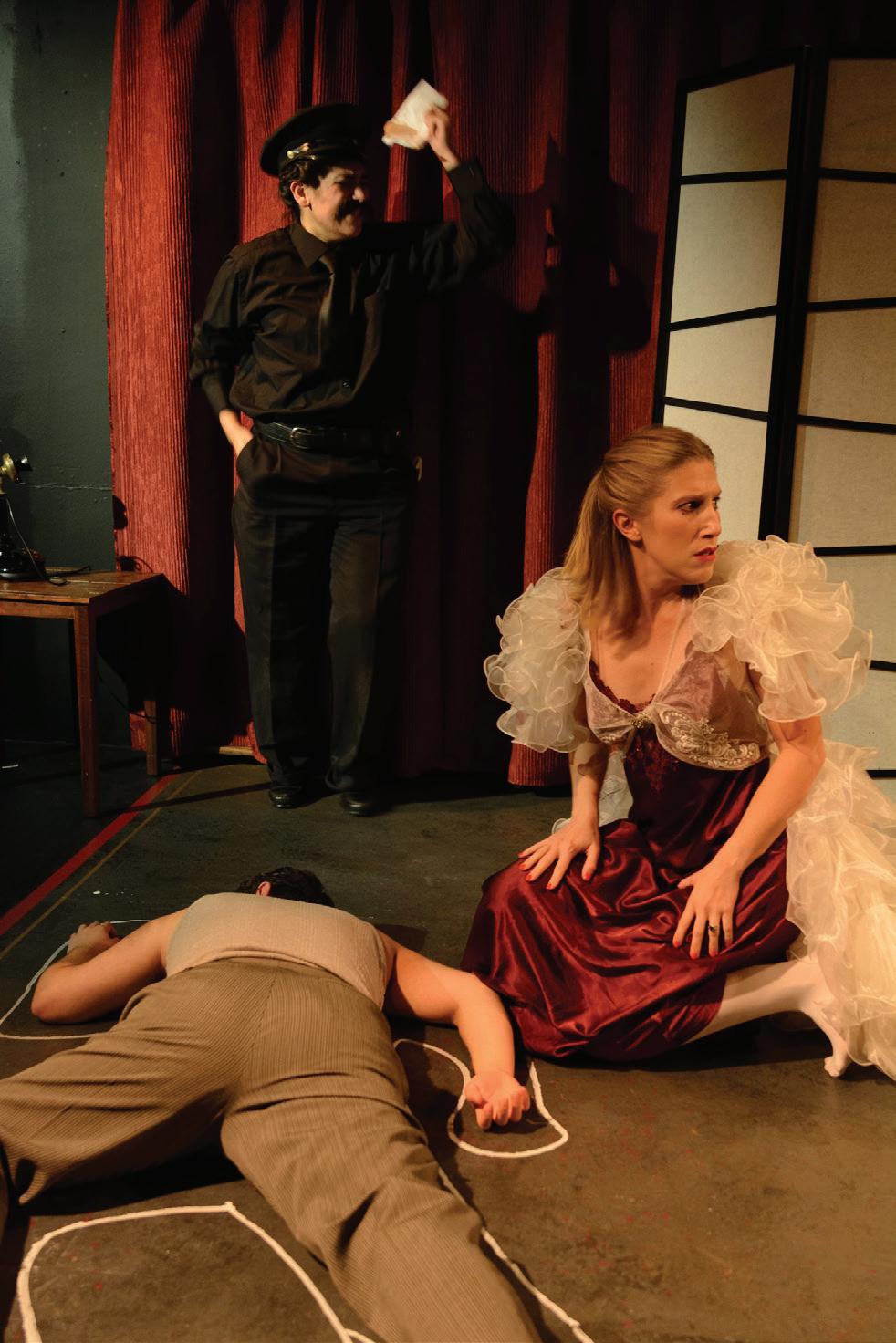
work for examining what power means in relationships and how families adjust to grief. Locke’s script provides us touching interludes about the limitations even self-sufficient witchy women face. Isobel’s rejection of a “nice guy” suitor sealed her fate. And the sisters’ mother “just wanted to be powerful enough to take anything the world threw at her,” but paid with her life for that quest. Tan’s staging incorporates plenty of impressive effects (Henry Toohey’s lighting design deserves special mention), and the cast (especially Diaz’s Isobel, who manages to be both world-weary and enthusiastic at the same time) is endearing. Locke’s play ultimately succeeds best at telling the more mundane yet moving story: siblings grow up, and sometimes they grow away from each other. It’s not magic; it’s life.
—KERRY REID ROOTED Through 11/2: Thu–Sat 7:30 PM, Sun 2 PM; masked performance Sun 10/26; Bramble Arts Loft, 5545 N. Clark, brambletheatre.org, $6.04-$42.79
RBloodthirsty baggage
City Lit and Black Button Eyes team up for Strange Cargo: The Doom of the Demeter.
7:30 PM, Sun 3 PM; also Mon 11/10 and 11/17 7:30 PM; City Lit Theater, 1020 W. Bryn Mawr, 773-293-3682, citylit.org, $40 (seniors $35, students/military $17)
RLove is in the air
Teatro ZinZanni Chicago’s latest celebrates immigrants and dreams.
It’s a bit like entering a set of nesting Russian dolls when you go see Teatro ZinZanni. First, you must journey to the glittering but small theater district in Chicago’s Loop. Then you enter the eloquent Cambria Hotel, walk through the velvet ropes, and take the elevator to the upper echelon of the 14th floor. That’s when they really double down on the opulence. Wrap yourself in velvet and moonbeams while you gaze at the mirrors and chandeliers. And that is before you even enter “ZaZou,” a rare Belgian Spiegeltent made of wood, canvas, and mystique. For all of that, they are still offering the best dinner-and-a-show deal in Chicago. It’s a true party scene that hearkens back to the days of speakeasies. Stick around because as the booze flows, the dinner eventually arrives, and most importantly, the show unfurls all around you like a feather boa on fire. The current iteration has a tight new cast of eight showcasing their new-to-you acts. They deliver the jokes, songs, and circus tricks with ease, keeping the audience riveted. But this time around, the theme is no joke. A message of love arises, and we are shown how people all come from someplace originally, most of those places not being the U.S. Director and seasoned performer Joe De Paul begins the trend. As the resident accountant, comedian, and crooner extraordinaire, the Canadian artist discovers his Italian heritage and leans in, offering great comedic relief.
The production has the genre’s go-to tropes: things that go bump in the night, shadowy specters, murky hallways, and dark secrets buried (literally) in the past. They’re all deployed with hair-raising effectiveness. Sounds that should be benign—running water, a doorbell, a droning podcast—thicken the atmosphere with a miasma of suffocating terror that peaks with a final, spine-chilling scene that isn’t just the mother of all jump scares: It’s a shock that will burn an a erimage into your eyelids.
—CATEY SULLIVAN PARANORMAL ACTIVITY
Through 11/2: Tue–Fri 7 PM, Sat 2 and 7 PM, Sun 2 PM; also Wed 10/22 1 PM, Fri 10/31 6 and 10 PM; Chicago Shakespeare Theater, 800 E. Grand, 312595-5600, chicagoshakes.com, $94-$99
RNobody here but us witches
Rooted combines magic with family dynamics.
Witches are popular this time of year: Lazy Susan Theatre Co.’s Wyrd already opened, and now Ben F. Locke’s Rooted, another tale of three sisters with magical
ous spell—which also damaged their powers. He’s sent a letter telling them he’s selling the house to Anthony, the hipster musician who lives upstairs with the girlfriend whose name none of them ever remembers. The sisters summon back from the dead a witch of centuries past named Isobel (Gabriela Diaz), who was burned at the stake. (The overall excellent costume work by Josephine Longo and Ophena De La Rosa really comes through in Diaz’s singed white dress.) They figure with her help, they can drive the interloper out and restore their previous abilities.
Isobel takes it in stride. “You’d be surprised how o en I get summoned, especially these last few years,” she observes. But as the sisters’ plans advance, cracks in their relationships grow. Merna is bent on vengeance (“We can still be good and do bad things,” she argues), Bailey is more of a healer than a hater, and Kassie has fallen for Ryan (Zhanna Albertini on opening night, ably stepping in for Haley Bolithon), the younger sister of the hipster, and is questioning her commitment to the coven entirely.
In essence, Rooted uses witchcra as a frame-
This City Lit/Black Button Eyes coproduction is a moody, macabre horror tale for the Halloween season. Scripted by Timothy Griffin and directed by Ed Rutherford, it’s based on chapter seven of Bram Stoker’s classic novel Dracula—sometimes published as a stand-alone story, “The Captain’s Log,” which chronicles the Russian merchant ship Demeter’s stormy, blood-drenched 1897 voyage from Bulgaria to England, where it crashes on the coast carrying a cargo of wooden crates filled with soil—property of a certain unseen Transylvanian nobleman whose grizzled servant, the mysterious Yorga, is the vessel’s only passenger. As the monthlong journey proceeds, the crewmen disappear one by one, until only the terrified, duty-driven, devoutly Christian captain remains to tell the tale.
Griffin’s adaptation—mostly somber but laced with streaks of black humor and intriguing references to pagan mythology—adds some surprising “whodunit” twists to Stoker’s original narrative. The solid ten-member ensemble—including Brian Parry as the captain, Herb Metzler as Yorga, and Jennifer Agather as a mute, acrobatic cabin boy—is buoyed by imaginative and well-integrated design work by Ruby Lowe (set), Liz Cooper (lighting), Beth Laske-Miller (costumes), Joe Griffin (music and sound), and DJ Douglass (projections), and Jeremiah Barr’s puppetry adds an unusual, eerily effective element to the evocative storytelling. —ALBERT WILLIAMS STRANGE CARGO: THE DOOM OF THE DEMETER Through 11/23: Fri–Sat
Japanese janitor Mariko Iwasa has a dream to make it big someday on stage, tap dancing. Who knows, maybe they’ll give her that big break right here in America’s favorite town. Spellbinding chanteuse LiV Warfield floats regally through the scenes, lending them the weight of her dignity—which they need, because there sure are a lot of shenanigans going on. Don’t blink or you might miss some mischief. Waiter/juggler Spencer Androli can’t seem to stop tossing and dropping things. Warfield performs on straps as the maid, also waiting for her moment to shine and bring a little class to the joint. Maître d’ Kyran Walton (a specialist in hand balancing, unicycle, and juggling) is burning out just trying to keep the staff in line, and hoops artist Aerial Emery is there to push the limits of chaos itself, to everyone’s good fortune.
As the story unfolds, Brazilian hair-suspension artist Danila Bim wraps up the evening with one of the most eloquent and jaw-dropping acts in town. As is always the case with Teatro ZinZanni, the talent is truly world-class, but this time around, the cast is also more American than usual. Perhaps international artist working visas don’t function on the same plane of acceptance and love that the show’s creators would like. Either way, this cast will have your group laughing, clapping, and possibly even getting a moment in the limelight themselves, which is the perfect night out. —KIMZYN CAMPBELL TEATRO ZINZANNI CHICAGO Through 12/31: Thu–Fri 7 PM, Sat noon and 7 PM, Sun 4 PM; also Thu 11/20 noon, Wed 11/26 7 PM, Mon–Tue 12/22-12/30 7 PM, Wed 12/31 8 PM; Sat 11/1, 11/22, 12/6, and 12/20 7 PM only; no show Thu 11/27 or Wed–Thu 12/24-12/25; Cambria Hotel, 32 W. Randolph, 312-488-0900, zinzanni.com/chicago, $98-$158 (see website for seating chart and meal information) v
Empower Illinoisans affected by breast cancer and reduce stigma with your purchase of a 7X Bingo Multiplier Instant Ticket from the Illinois Lottery
You could call it the Instant Ticket that started it all. In 2006, the Illinois Lottery launched the Ticket for the Cure (TFTC), the first-ever specialty lottery ticket in the United States that dedicated 100 percent of profits to breast cancer research, awareness, and education. Since its inaugural year, the ticket has raised more than $17.6 million in grant funding for medical research centers and community organizations across the state of Illinois, which is distributed by the Illinois Department of Public Health. In 2024, the Illinois Lottery introduced a new joint specialty ticket where a portion of the profits raised supports organizations and researchers that educate and advocate for breast cancer support and awareness, along with nine other worthy causes. This year’s joint ticket is the 7X Bingo Multiplier, and has a joyful, bright-green color, costs $5, and is available for purchase at more than 7,000 Illinois Lottery retailers throughout the state. Visit the Illinois Lottery website for more information.

Breast cancer is an illness that impacts every community and walk of life. Despite the universal nature of that reality, though, there’s no one-size-fits-all approach to educating the public and spreading awareness about the disease to ensure that everyone facing or at risk of developing breast cancer attains the support and resources they need. The challenge becomes even greater in communities where factors such as language and literacy barriers, income disparities, social stigmas, and a historic lack of trust in health-care institutions come into play. And the stakes are high: According to the American Cancer Society, breast cancer accounts for 30 percent of all new female cancers each year and one in eight women living in the U.S. will be diagnosed with the disease during her lifetime. Furthermore, breast cancer is the second leading cause of cancer deaths among American women (following lung cancer), and given current rates, one in 43 women will eventually pass away from the disease.
That’s why community-based organizations such as Midwest Asian Health Association (MAHA) are so vital in saving lives. The Chicago-based health-care group was established in 2003 with a mission to reduce health disparities for medically underserved and low-income populations in the Midwest region through providing culturally sensitive and linguistically appropriate services, collaborating with grassroots organizations, health-care providers, academic institutions, public health departments, and a network of volunteers. In the 22 years since they started, MAHA has grown to have four locations, including their main Chicago office on 26th Street, and additional offices in Chinatown, Bridgeport, and Naperville.
MAHA offers a wide range of programming, including healthcare navigation, family advocacy, mental health services, and employment services, among others. Their breast cancer initiative
has been an important part of their work since they launched it in 2016—and with the grant funding they received through the Illinois Lottery’s specialty ticket program in July, they’re poised to make a greater impact than ever in combating breast cancer in the communities they serve.
“MAHA is ready,” says MAHA program manager Mei Kan. “First of all, we definitely want to expand access to mammograms, breast cancer treatments, and health education. The second mission is to strengthen the cultural and linguistic education outreach to reduce stigmas in the communities we serve. And lastly, we have a multilingual team of navigators who can provide one-on-one guidance.”
According to the Illinois Department of Public Health (IDPH), breast cancer incidence rates among Asian women in Illinois are
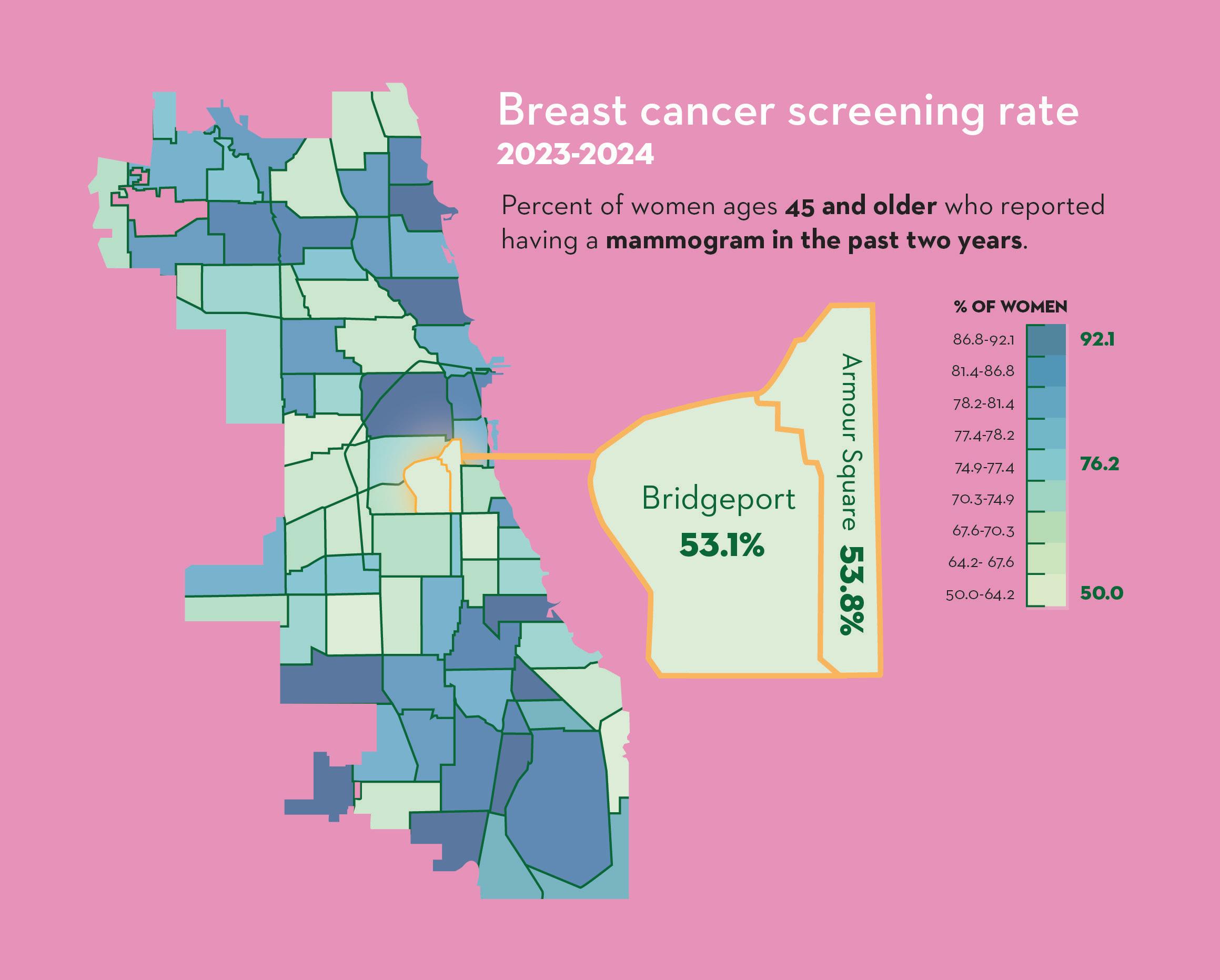
111.6 out of 100,000, compared to a figure of 132.0 out of 100,000 for all races combined. In addition, the mortality rate for Asian women with breast cancer is 10 out of 100,000 compared to 20.5 for white women and 29.6 for Black women. But Kan says that there’s more to those figures than meets the eye.
“From my experience working with the Asian community, we realize the rates are lower than other racial groups,” she says. “That’s not because AAPI doesn’t get breast cancer, it’s that there’s so many stigmas and challenges for AAPI to get screened or complete their mammogram,” Kan says. “[The lower rates] make everyone think, ‘Oh, you guys are good—you probably don’t need that much attention.’ That’s one of the reasons MAHA wants to step in and have people educated and promote how important mammograms are.”
Kan says MAHA has been able to expand their breast cancer services over the years, building a robust network of local healthcare providers and hospitals, where, for example, they can make arrangements for a shuttle bus to transport groups of clients to mammogram appointments and back. More recently, they’ve collaborated with health-care institutions and local nonprofits to provide a mammogram mobile van onsite at their office. Their
current target, she says, is to get “at least 200 people screened per calendar year.”
The screenings are just one piece of an overall picture. “Before we had this breast cancer grant, the only thing we could do was to refer [clients] to physicians that we have relationships with. But now we can provide more of a 360 degrees of care,” she says. “We can connect them with social workers or community health workers that speak their language to support their whole treatment process. It really depends on the individual’s needs.” Clients can also receive referrals to MAHA’s mental health clinic, where they can access counseling services. Kan says the organization will soon launch a new program of cancer support groups for patients, family members, and caregivers.
Language is a top priority for MAHA’s clients, and Kan says they currently provide services in six languages, including Cantonese, Mandarin, and Taishanese. “Most of our clients are immigrants. No matter where they came from, we try our best to match our staff who speak their language to support them or be their interpreters and help them make appointments,” she says.
Along with language barriers, MAHA must also confront stigmas
and misinformation about health screenings in the communities they serve. Kan recalls clients repeating false information they saw on social media or heard through friends and relatives from various parts of Asia. “You can save so many lives by doing these screenings, but we have this false information floating around making people feel like, ‘I feel fine so I don’t have to do anything—and even if I have cancer, it’s better for me not to know.’ It’s the stigma of cancer. I feel like, for most of the AAPI that I know in this community, they are so afraid to even hear the term mentioned to them.”
To help combat misinformation and stigmas, MAHA provides materials in multiple languages detailing myths and facts about breast cancer, instructions for self-exams and how to recognize red flags so they can discuss their concerns with their doctor. “Oftentimes, their primary doctor will tell them, ‘Oh, you should do a mammogram,’ and they’ll do it. So it’s about finding strategies to help them be more willing to talk about it and even do some screening or treatments.”
With your purchase of a 7X Bingo Multiplier Instant Ticket from the Illinois Lottery, you can help MAHA and other local organizations change the conversation around breast cancer, one person at a time. “In the past, we only had connections with certain clinics, but since we have this grant, we’re now expanding the map and seeing more resources we can offer our clients,” Kan says.
For more information about the Midwest Asian Health Association and their breast cancer initiative, visit: maha-us.org

FILM
NOW PLAYING
RFrankenstein
Guillermo del Toro’s lifelong love of Mary Shelley’s 1818 novel Frankenstein has guided his career. His own devotion to the grotesque is mirrored in the story’s collision of tenderness and monstrosity—its sense that beauty and horror spring from the same wound. With Frankenstein, the director constructs a reverent tribute to the story, emphasizing his favorite line: “I have love in me the likes of which you can scarcely imagine and rage the likes of which you would not believe. If I cannot satisfy the one, I will indulge the other.”
Del Toro spent nearly 25 years dreaming up this world, and it shows, especially in Dan Laustsen’s gorgeous cinematography and Kate Hawley’s opulent costume design. Jacob Elordi brings fury and passion to Frankenstein’s monster. In the opening sequence, he’s bone-chilling as he thunders across ice toward an ice-locked ship. Then he charges, taking bullets and smashing soldiers with sights on Victor Frankenstein (Oscar Isaac). The ship captain (Lars Mikkelsen) sinks the monster and saves the injured doctor, who begins to share his story.
Victor is the son of a surgeon whose failure to save his mother (Mia Goth) during childbirth instills in him an Oedipal drive to subvert death. Del Toro spends plenty of time on Victor—his fraught relationship with his broth-
er William (Felix Kammerer) and his forbidden love for Elizabeth (also Goth), his brother’s fiancee—before bringing the monster to life. We’re steeped in Victor’s death obsession, entangling us in his madness and frustration. Then we switch to the monster’s perspective. Del Toro compassionately shows the monster reckoning with his existence: how violence becomes ordinary to him and how love mutates into suffering and rage.
This damning fable of a man who wanted to cheat death finds its beating heart in the complicated paternal folly between Victor and his monster. One of the film’s most persistent themes is how ambition suffocates compassion. As Elizabeth exclaims: “Only monsters play god.” —MAXWELL RABB R, 149 min. Limited release in theaters, streaming on Netflix Fri 11/7
A House of Dynamite
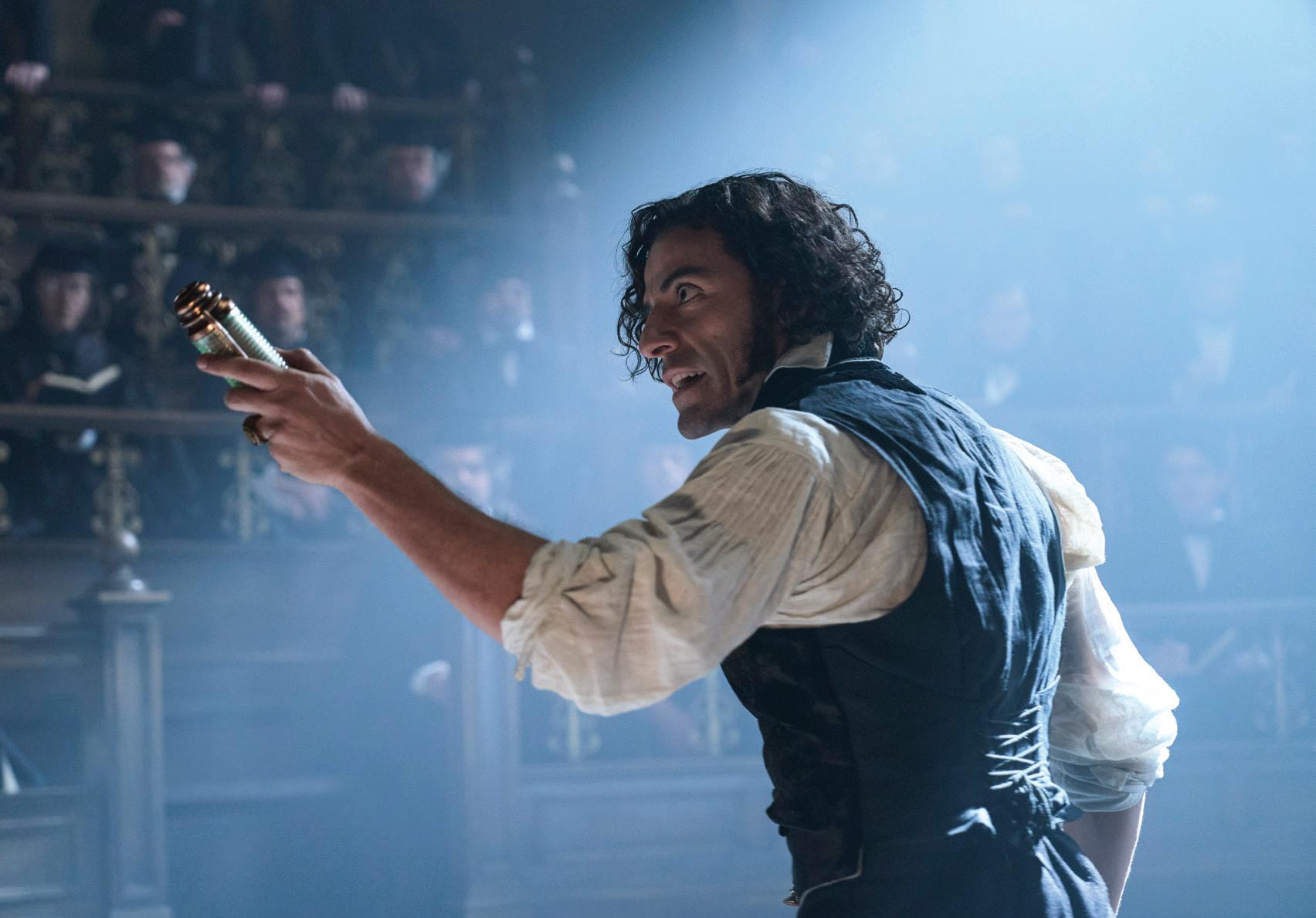
Everyone in Kathryn Bigelow’s A House of Dynamite wakes up for work bright-eyed and dutiful. Even at the top level of national security,

the grind is ordinary: routine briefings, jokes between coworkers, and the practiced rhythm of any job done out of habit. Bigelow expeditiously shows how comfortable the American psyche has become, even for those tasked to manage catastrophe.
But now a nuclear warhead is hurtling toward the midwest with 19 minutes to impact. What next? Cold war–era filmmakers asked what happens when “the” bomb drops, from bureaucratic panic in Fail Safe (1964) to full-on collapse in Threads (1984). Theirs were worlds braced for impact. Bigelow uncorks this legacy of nuclear paranoia for characters mired in routines where they never expect the worst.
Across three vignettes, Bigelow restages the same 19 minutes, shi ing between three people charged with preventing, well, the end of the world.
The first chapter follows
Olivia Walker (played by the movie’s shining star, Rebecca Ferguson), a senior situation room officer who arrives at work just as a nuclear missile is detected. As the nuclear clock ticks down, every fail-safe and plan falls apart. People become paralyzed at the moment they’re meant to act. This is the most tense of the three sections, anchored particularly by startling performances from Ferguson and the actors playing her quickly fraying base crew.
As the clock approaches zero, A House of Dynamite resets to the beginning of a panicky day for deputy security adviser Jake Baerington (Gabriel Basso), then one with the U.S. president (Idris Elba). As the film enters its final stretch, Bigelow’s taut narrative loosens. Her return to familiar characters teases profound insight it never delivers, instead reiterating what was already clear: Everyone is a bumbling fool—especially the good-hearted president, who hears the news at a kids’ basketball event. He feels more like a mascot than a commander in chief, and the triteness of his story undercuts what made the opening so effective: the surprise reckoning for which no one is prepared.
As a whole, the vignettes consume one another’s force. Bigelow tests whether anyone could genuinely bear the panic, but that question feels glib. C.S. Lewis once said, “If we are going to be destroyed by an atomic bomb, let that bomb, when it comes, find us doing sensible and human things.” Bigelow seems to suggest sensibility might be too much to ask. —MAXWELL RABB R, 112 min. Limited release in theaters; streaming on Netflix Fri 10/24 v





Over the weekend I attended Music Box of Horrors for the eighth or ninth time. It was a blast—of all the annual 24-hour horror marathons at the Music Box Theatre I’ve experienced, it may have been my easiest, to which I credit my neck pillow, a constant stream of energy drinks, and regular ibuprofen helping to keep the soreness at bay. I lasted until around 5 AM. In total I watched six movies; I missed a couple because around 7:30 PM I had to go to Doc Films at the University of Chicago for another volunteer shift. More on that later.
My favorites of this year’s marathon were Chicago filmmaker John McNaughton’s 1991 film The Borrower and Larry Cohen’s 1987 film It’s Alive III: Island of the Alive (though I do want to shout out the gorgeous 35-millimeter print of Ishirō Honda’s 1963 film Matango , which was imported from Japan). The Borrower is about an outlaw alien sentenced to Earth as a human. Every so often the alien begins expanding outside its current human form and must decapitate another human to assume its head, all while law enforcement rushes to solve the case of this mysterious serial killer. The post-screening conversation with McNaughton was interesting, especially with regard to how the film came to be. It amazes me that any film manages to get made, as every story I’ve heard about a low- to mid-budget movie has been rife with production woes, and this was no di erent.
It’s Alive III: Island of the Alive was weirdly touching. I’d seen It’s Alive (1974) but not It Lives Again (1978), though it didn’t matter because the film works as a stand-alone. Stephen Jarvis (Michael Moriarty) is the father of a mutant baby who is exiled to an island after
FILM
It’s Alive III: Island of the Alive

a court battle to spare mutant children from routine extermination.
Some years later Stephen is recruited to join scientists who are going to the island to study how the children have grown up. There, he learns his son desperately wants to return to see his mother, Ellen (Karen Black), who’s left Stephen and has chosen to live as though they never had a child together. Nevertheless their son wants to reconnect—and goes to great lengths trying. The cast is great, and it was so emotionally stirring at 3 AM. Schlock seems to have won out this year, but Cohen’s film shows how poignant schlock can be.
Midway through the marathon I had to leave to be a fireguard for Doc Films’s 10 PM screening of Takashi Miike’s Dead or Alive (1999), which I was generally happy to do; I quite like the prolific Japanese auteur, whose oeuvre spans myriad genres. It’s a wild film—my husband likened it to 70s John Waters, but it’s a lot meaner. I mean, at one point, a woman is drowned in a pool of her own excrement. The film has a berserk ending, too, which I won’t spoil. I’ll just say it comments on the cyclical nature of violence. Randomly, it reminded me of a film I had seen earlier in the week, Jafar Panahi’s It Was Just an Accident (2025), at a press screening for the Chicago International Film Festival. Both center on the idea that revenge and the continuation of violence are ultimately fruitless. Miike goes so far as to suggest that it could result in the end of the world as we know it in a very unexpected way. Until next time, moviegoers. —KAT SACHS v
The Moviegoer is the diary of a local film bu , collecting the best of what Chicago’s independent and underground film scene has to o er.
REVOLUTION(S)
BY ZAYD AYERS DOHRN
MUSIC AND LYRICS BY TOM MORELLO DIRECTED BY STEVE H. BROADNAX III

When soldier and aspiring musician Hampton Weems comes home from Afghanistan, he finds the South Side of Chicago is also occupied territory—and he’s accidentally joined the resistance. This all-new radical musical event from Rock and Roll Hall of Famer Tom Morello (Rage Against the Machine, Audioslave and The Nightwatchman) and Chicago’s own Zayd Ayers Dohrn pulses with punk, hip-hop and metal, and celebrates the courage that inspires us—across generations—to demand a better world.
STARTS OCTOBER 4
GROUPS OF 10+: GROUPS@GOODMANTHEATRE.ORG
MUSIC
Anonymous, gun-wielding goons wearing gas masks and military camo burst into a Chicago apartment and inflict indiscriminate violence on everyone they find. This is a reality we have to face now that Immigration and Customs Enforcement agents are nearly two months into Operation Midway Blitz; it’s also exactly what happens in a no-budget dystopian movie called Nightmare City, made in Chicago in the early 1980s by outsider glam rocker John Henry Timmis IV. Up till that point, Timmis had focused his creative energy on music. In 1980, he’d self-released two seveninches, “Waiting for the CTA” and “Destructo Rock,” under the name J.T. IV. An original copy of that first single sold for more than $3,000 in 2022, but at the time, Timmis’s recording career failed to take o . He was frustrated, but he wasn’t willing to abandon artmaking entirely. He decided to redirect his e orts into the even more challenging field of filmmaking.
Timmis had no experience making a feature film when he embarked upon his directorial debut in 1984. Nor did he have much money. He did have a Super 8 camera and a lot of ideas about what to do with it. As Timmis would later write in his posthumously published memoir, “My first feature-length picture was called Nightmare City , a George Romero ripo about the country being taken over by killers who had orders from the government to exterminate all undesirable citizens of America.”

’
J.T. IV S WILD HORROR TRASH
JOINS THE BLU-RAY CANON
The outsider musician, writer, and filmmaker born John Henry Timmis IV made zero-budget movies with a punk urgency that carries across the decades.
By LEOR GALIL

Thanks to his considerable charisma, Timmis also had people to fill out his cast. “You couldn’t help but be involved with him,” says Oak Park lawyer Damon La Porte, who had a small role in Nightmare City. La Porte’s best friend, Kurt Jacobson, had an older brother named Tim who was close with Timmis. Kurt recruited La Porte for a party scene that ends in a bloodbath, and La Porte had a blast working with Timmis. “Once you got a taste of his energy and his excitement . . . you know, he was kind of a leader,” La Porte says. “He was a big character. He was funny and very engaging.”
Timmis self-released Nightmare City in a short run of VHS tapes later in 1984. Like his

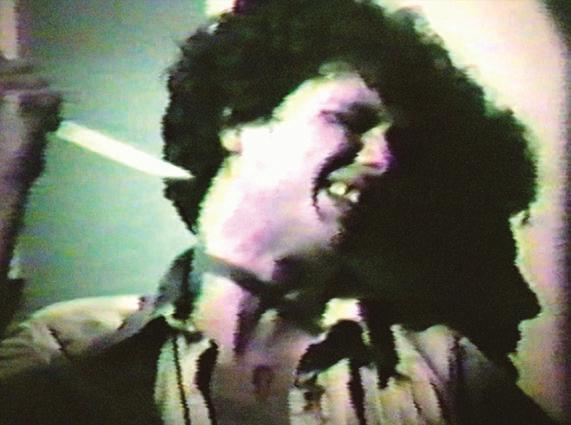
records, it disappeared basically as soon as it came out, leaving hardly a trace. His next feature, a 1985 horror flick called Cannibal Orgy , was about a murderous satanic cult, and it fared slightly better—if you’re willing to accept as “better” a mention of the movie in a 1992 Tribune piece about cannibalism on film. Critic Bill Dahl mostly poked gentle fun at its budgetary limitations. “When you can only a ord one take of a scene,” Dahl wrote, “even cannibalism has its limits.”
Despite his lack of technical know-how and storytelling savvy, Timmis made some
profoundly strange films. They’re compelling in their own awkward, messy way. If you like scary movies that emphasize disturbing vibes over coherent narrative, you might dig the gnawing, paranoid dread of Nightmare City or the psychotic gore of Cannibal Orgy. Timmis’s Super 8 footage is far from perfect, but the grainy texture and smeared colors make his films look creepily authentic—like they could be pieced together from home movies shot by real people of actual events. (The low-quality image also helps hide some of the cheapness of the e ects.) The satanic cult in
Cannibal Orgy—whose members are played by Timmis, poet Lee Groban, and others—spends a significant portion of the film’s running time feasting on human entrails that are clearly pieces of uncooked meat. Timmis trains his camera on fictional gore and violence for such prolonged periods that you start to worry about him.
“This is like AP underground horror—it’s not something you just step into,” says Joseph A. Ziemba, cofounder of fringe cinema publisher Bleeding Skull. Launched in 2004 as a blog about underground and unknown cult movies, Bleeding Skull has since published two books on the topic. Last year it launched a boutique Blu-ray label to make these often homemade and usually hardto-find pictures accessible to new fans. This past March, Bleeding Skull issued Cannibal Orgy and the Films of J.T. IV, which compiles Timmis’s first two features and several short works.
“We watch a lot of no-budget DIY horror movies for Bleeding Skull,” Ziemba says. “Tons, thousands, millions at this point. Lots. I think the ones that I’m always drawn to are the ones that feel like the person had to get this o of their chest—like, it wasn’t just a passing interest. They had to do this in order to keep on living. Those are the ones that feel like they cut the deepest, when you think about the emotions and the psychology behind them.” For Ziemba, Timmis’s wildly creative nightmare visions, executed with barely any resources, elevate his films into this canon.
Ziemba and Bleeding Skull editor Annie Choi first saw Cannibal Orgy after buying Cosmic Lightning , a reissue compilation of J.T. IV’s music. The comp had originally been released in 2008 by Drag City imprint Galactic Zoo Disk (run by Steve Krakow of Reader series the Secret History of Chicago Music), and in 2013 it came out in a new edition that included a DVD with Cannibal Orgy. “We weren’t really sure what to expect,” Choi says. “‘A free movie with a record’ isn’t exactly the biggest selling point. But based on the name and based on the aesthetics of the music itself, we thought it’d be up our alley. It was totally punk, and we loved it.”
MUSIC
Timmis died in 2002. He might never have escaped obscurity if historian and record collector Robert Cole Manis hadn’t heard J.T. IV’s knuckle-dragging scorcher “Death Trip” on a mid-2000s compilation of obscure punk called Staring Down the Barrel. Manis set out to dig up everything he could about Timmis, and the 2008 Cosmic Lightning release was just the first of many.
In 2017, Featherproof Books gave Timmis’s memoir, From the Inside , its long-delayed first publication. Written in the 90s, it mostly details his teenage stint at Kansas’s infamous Menninger Clinic in the late 1970s. In 2023, Galactic Zoo Disk issued a second J.T. IV compilation, The Future, whose contents came at least in part from a demo cassette discovered by an Illinois Entertainer contributor early in the pandemic.
All these releases—From the Inside, the J.T. IV records, the Cannibal Orgy Blu-ray—deepen the lore surrounding Timmis. And there was plenty of lore to begin with, given how dedicated Timmis was to spinning his own myths. In 1988, he credited his final seven-inch, Live in Concert , to “Frankenstein,” having sent notices to local papers announcing that he’d been disfigured in a tra c accident and would be performing under this new name while wearing a mask. The accident never happened, of course, but this stunt was part of what drew Ziemba to Timmis’s films.
“It falls into the same lineage, for me, as movies like Last House on Dead End Street and Deadbeat at Dawn,” Ziemba says. “These larger-than-life stories behind the movies, and these characters making the films that have their own self-mythology.” Timmis shamelessly promoted his music in his movies too. Early in Nightmare City , his character announces that he’s playing a record by J.T. IV, and Cannibal Orgy incorporates a performance by Insane Albino, an ad hoc band led by Timmis. He also pu ed up his movies with outright fabrication: Cannibal Orgy is preceded by a message that claims it’s been banned in 20 countries.
Manis went to great lengths to learn the basics of Timmis’s biography, a process he discusses in the Cannibal Orgy commentary track. As Manis told the Reader in 2008, Timmis was born in 1961 in Warren, Pennsylvania, and moved to Athens, Ohio, with his family as a child; his father taught at Ohio University for a time. (I highly recommend that commentary—Manis also discusses tracking down the film’s meat budget.)
It’s a good thing Manis began his research

into Timmis in 2007, since in the intervening years several of the people involved in his films have died. Among Timmis’s friends, Lee Groban was the first Manis met, and he passed away in 2011. But Manis was able to put me in touch with Tim Jacobson, who’d been important in the production of Nightmare City
This year’s Bleeding Skull Blu-ray is the first reissue of Nightmare City, and Jacobson had the sole surviving copy of the movie. The Blu-ray release was helped along by the fact that Nightmare City made it less redundant with the earlier discs, the contents of which had come mostly from Suzanne Lehmann, Timmis’s former wife. “Right o the bat I had tapped into a large amount of footage, which was exciting,” Manis says. “It wasn’t until a couple years ago that I found Tim, who I coldcalled one day and he was like, ‘I knew John—I have one of his films, Nightmare City. How’d you find me?’ As far as other opportunities to release the films, there wasn’t much action until Nightmare City surfaced. That really set things in motion.”
“I helped [Timmis] out,” Jacobson says. “I was there for the whole movie.” He was there for much of Timmis’s musical career as well— they’d become friends in 1975. When Timmis needed help paying to press his first record, Jacobson gave him $100. “I got a bunch of his ‘Waiting for the CTA’ records,” Jacobson says. “I wasn’t even selling them—I was just giving them away. Now they’re worth thousands of dollars.”
Timmis pitched Jacobson on Nightmare City in spring ’84. He explained that he couldn’t pay the cast or crew up-front, but he said that if the movie made any money, they’d get a cut
of the profits. Jacobson helped drive actors and equipment to filming locations on the far north side and suburbs, including Timmis’s Rogers Park garden apartment and Calvary Catholic Cemetery in Evanston. Jacobson played a variety of no-name characters in the movie, ad-libbing dialogue and rolling with whatever Timmis threw at him.
“A lot of this stu was just one take,” Jacobson says. “We talked about the scene, we shot it, and then that was it.” By the end of the summer, he had a finished but extremely rough copy of Nightmare City , apparently made by projecting the film and shooting the screen with a VHS camera.
It’s a miracle that Timmis’s movies have made it to Blu-ray—they weren’t just obscure, they also barely existed on any salvageable format. “We had one source; if there are any issues, there’s nothing else to turn to,” Ziemba says. “Cannibal Orgy actually feels like it was transferred professionally, from whatever Super 8 master he had to tape. But Nightmare City was one that he clearly had projected on the wall and then recorded the audio with a microphone next to the projector. They’re both really rough—they’re probably the roughest elements we will ever work with in our lives.”
The resurfacing of these movies gives me some hope that another Timmis film might become available again: The Cure for Insomnia, which holds the Guinness World Record for the longest movie ever made. It’s more than 80 hours long, and much of that footage consists of Groban reading from his poem of the same name (which had topped 4,000 pages by 1994). It also reputedly includes newsreels, action scenes, heavy-metal videos, and porn. A brief excerpt appears on the Bleeding Skull Blu-ray, but the complete film has long been considered lost. But that may no longer be true: In the Cannibal Orgy commentary track, Manis reveals that Groban’s sister recently found a complete copy of the film and is in the process of digitizing the tapes for distribution.
In From the Inside , Timmis complained about the notoriety of his record-setting movie. “It is funny how my worst creative projects are the ones most appreciated by the public,” he wrote. If only he had lived long enough to see the films he’d actually wanted people to watch get the deluxe reissue treatment on Blu-ray. v
CHICAGOANS OF NOTE
Dewey Burtker, hardcore-scene artist and musician
“Young kids who are stoked on the right stuff, that is hands-down what’s keeping me interested. A lot of people age out.”
As told to LEOR GALIL
Punk lifer and artist Dewey Burtker moved to Chicago just as COVID-19 shut down live music. He was a huge fan of hardcore, and once bands could play out more often, the scene would explode—the 2021 release of Turnstile’s Glow On had helped light the fuse. Dewey devotes his talents to this burgeoning community, including by drawing show flyers and album art. His knotty, spiky, aggressive style hybridizes hip-hop graffiti with the handmade copy-shop aesthetic of 80s cassette demos. He’s also a musician, and has played drums in Instill and bass in Buggin. The latter band delivered their farewell set in August at a benefit for Sudan and the Democratic Republic of the Congo at the First Presbyterian Church of Chicago.
Istarted going to hardcore shows when I was 11, in the Bay Area. In 2010, 2009, 2011, a lot of hardcore show flyers were really crazy—do you remember the Hot Topic T-shirts they used to do where it was some gnarly illustration that looked 3D rendered? It was always something that was confusing to look at. I grew up listening to Bad Brains and Minor Threat and watching the Another State of Mind documentary; you would see all these bands that basically just put together stencils of cool logos. Everything was hand drawn. That really pulled me.
The more I got into it—listening to any Revelation Records bands and bands from the 90s and 80s—you would dive into any Sick of It All show flyer, like, “This is so cool. These are a bunch of kids with pens and paper, at a Xerox

machine, figuring it out. I wanna try to figure out how to do that.”
In high school, I took an art class. My teacher used to hit me with paper, ’cause I was a senior when I took the first class, and she was like, “Why weren’t you here freshman year?”
So I never really had any formal training. There was a bunch of artists in the scene at that time. Like Augie B [of Strong Images], who was from Chicago, I think lives in Virginia now, he was doing a lot of really cool flyering stu . And Chris Wilson up in New York, he had the craziest style.
Especially during that youth crew [revival] in 2012 to 2016, they had some of the coolest art. Moshers Delight [Records] and all those releases were really a revival of what was happening in the 80s. It was like, “How do I figure that out? And make my own style out of it?” Just through practice. Every single day, coming back from a class from college, I would sit there, finish my homework, and then just doodle for hours and try to perfect whatever I could.
I really started drawing in 2018. I was figuring out how to transfer what I was doing into
[a digital] application. For my job, I luckily had Photoshop and the Adobe suite. I was using a lot of Illustrator, and I didn’t really know what I was doing, so I was watching a ton of YouTube videos of “How do I do this? How do I get this look?” I was playing around with a bunch of di erent styles.
I had friends from the scene that were in bands, but I hadn’t really been in contact with them through college. I was living in Champaign, Illinois, because I went to the U. of I., and there really was no scene at that
“Hey, do a T-shirt. Do this. I love this—can we use this?”
I always loved doing flyers. It felt like the most creative I could be. And there wasn’t a lot of pressure involved, because this is really cool, but this isn’t going on a T-shirt. No one’s making money o of this; I can just do what I want. Through that, I found myself figuring it out. It wasn’t until probably 2020 that I really kind of homed in on . . . not necessarily my style, ’cause it’s all natural, but what felt most comfortable to me.
“I always loved doing flyers. It felt like the most creative I could be. And there wasn’t a lot of pressure involved, because this is really cool, but this isn’t going on a T-shirt. No one’s making money off of this; I can just do what I want.”
time down there. I was in this bubble of that campus, still being stoked on hardcore. I wasn’t playing in bands anymore. So when I came back [to the scene] and started doing designs, a couple friends of mine were like,
I lived in California for 18 years, in San Jose. All these yuppies were coming in; the whole landscape was changing. There were no more mom-and-pop shops. Everyone kind of sucked in the area that I lived in, which was pretty
a uent. There wasn’t any real culture at that point. It was too expensive to live there. A lot of my friends that I still have that are out there are just getting by with full-time jobs, but they can’t even a ord rent. I always knew I wanted to get out and try different things. Going to Illinois, [I] just loved the school. The pipeline, from all the friends I made there, was “You gotta go to Chicago.” I’ve been here for about six years now.
In college, I didn’t play in any bands. Hardcore was in a weird place in those years, transitioning from that youth crew revival, which is what I loved, into the more heavy stuff that was coming out of the Bay Area—you know, Sunami, Hands of God, you name it. When I got to Chicago, it was still during COVID; the first show [I went to] was my buddy Nick [Acosta] from NMZ [New Morality Zine] had this showcase at Beat Kitchen. I’d met a lot of these people on the Internet, but all right, here we are in real life. Nick introduced me to these two guys who turned out to be Peyton [Roberts] and Michael [Rasmussen] from Buggin.
Mike actually did the drums and sang on the demo. They showed it to me. I was like, “Absolutely, without a doubt, let’s get it going.”
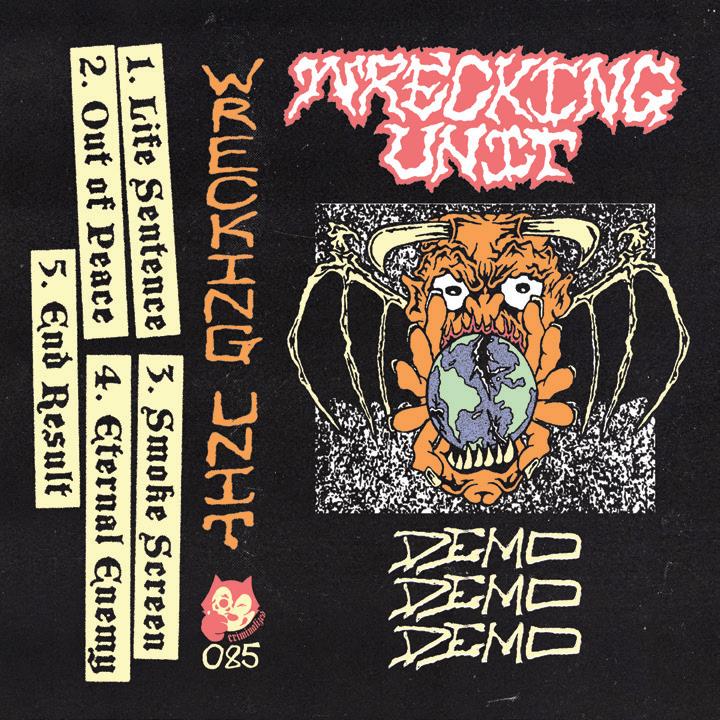


We’re sitting outside of the show, and they were like, “Hey, are you straight edge?” I literally had a beer on the table. I was like, “Uh, no.” They were like, “OK. Do you know anyone that drums?” I was like, “Well, I drum.” They were like, “But you’re not straight edge.” I was like, “No. Is that a problem?” They looked at each other a beat and went, “Ah, that’s fine.”
They had already had the [Instill] demo written, just recorded with the two of them, with Peyton doing all the guitars and bass.
I had gone to Peyton’s a few times to practice with him on an electronic drum kit in their little apartment in Ravenswood. The neighbors were complaining because the kick pedal was bouncing against the floor. We had to find a practice space. We’d go to Mystery Street [Recording] over in Lincoln Park. I have a buddy, Duncan [Frey], who I knew played bass. He was also getting back into hardcore—so he was really excited. The four of us started off as the original lineup. [We] put out the demo [and] played a bunch of shows on it. We were so surprised that it resonated with kids. We were playing what we loved, and we weren’t sure if, like, that might’ve been retired five, four years previously. We got a pretty positive reaction. It enabled us to be that house band for a lot of our friends coming here.
We basically played everything and anything we could for two years. Then my buddy Jake [Linkiewicz] joined on second guitar and we became a real band, which was cool. It was kind of funny because Instill, we never really wanted to tour. Michael and Peyton were in Buggin, which was a full-time band. This was kind of our passion project. Then me and Jake from Instill ended up joining Buggin, because a couple of their members dropped out. It was the dichotomy of, “Here’s Instill, which is the
local band that’s more youth-crew oriented, and here’s Buggin that’s the more accessible hardcore thing.” It was fun to do both. Playing in Buggin was really cool because they had already done all the legwork to be where they were at. They already signed to [Baltimore-based label] Flatspot. What started o as me filling in for the Audiotree thing ended up with me being like, “I guess I’m sticking around.” We played so many shows all over the country and abroad as well. I didn’t have any expectations; I hadn’t seen it from day one. The last show, we crammed 500 kids into that church down south. People were going nuts. It’s a bummer to say goodbye, but it was time. It’s cool that we got to go out with all of our friends and for a good cause.
Young kids who are stoked on the right stu , that is hands-down what’s keeping me interested. A lot of people age out. Friends I’ve had that were into hardcore for years are no longer interested; they’ve got full-time jobs, they’re starting families, which is totally normal and awesome. I applaud that. But the number dwindles of the friends you used to





go to a show with when you’re 16, 17, 18 years old. Then you worry about, like, “What’s the longevity of the scene?”
All over the country right now, all these kids are coming out with brand-new bands that are, you know, not rip-offs, but are inspired by Youth of Today, Battery, inspired by Beyond—and they’re doing it correctly too. They all mosh cool, they look cool, they’re all nice people. They have the ethics and everything pretty much down.
If I had to tell you what’s one band that keeps me doing what I’m doing, it’s probably this band from Minneapolis called Everybody Takes One. It’s all these kids who are pretty young—they started a band, put out a badass demo, and they tour all the time. Seeing that is what really excites me and keeps me involved. Because if it was just me and the old guys, we can be a little disillusioned sometimes with what we thought was exciting when we were young. But now, seeing kids be super stoked and doing it correctly, that’s so exciting to me. v
m lgalil@chicagoreader.com




Our annual celebration of outstanding Chicagoans

















MUSIC

Recommended and notable shows with critics’ insights for the week of October 23 b ALL AGES F
PICK OF THE WEEK
G Herbo celebrates his 30th birthday with ten thousand of his closest friends
SWERV & FRIENDS FIRST ANNUAL BIRTHDAY BASH FEATURING G HERBO, A BOOGIE WIT DA HOODIE, 21 SAVAGE, POLO G, MEEK MILL, 42 DUGG, NARDO WICK, SKILLA BABY, HUNXHO, QUEEN KEY, AND YK NIECE Sun 10/26, 7 PM, Wintrust Arena, 200 E. Cermak, $133–$351.50. b
DRILL RAPPER G HERBO didn’t need to book Wintrust Arena for his 30th birthday party to demonstrate his status as one of Chicago hiphop’s greatest exports. Herb’s stardom seemed assured from the beginning: His stunning 2014 debut, Welcome to Fazoland (released as Lil Herb), propelled him to notoriety with hardened performances and world-weary lyrics that let you feel along with him that nothing in life can be guaranteed. In the 2020s, he’s released a string of albums that hit the top ten of the Billboard 200 (the 2021 release 25 did best, reaching number five), but his course has seemed far from certain—in large part because in 2020 he was entangled in a headline-grabbing federal wire-fraud case. As Rolling Stone senior news editor Althea Legaspi detailed in a 2024 profile of Herb, he’d hired promoter Antonio Strong for various services (private jet travel, luxury car rental), and Strong was involved in a wirefraud conspiracy. Because Herb paid Strong for things Strong had used stolen credit-card info to get, the rapper was indicted in a federal case. In 2023, Herb pleaded guilty to one count of making a false statement to a federal o cial and one count of conspiracy to commit wire fraud. Herb was sentenced to three years probation and slapped with more than a quarter million in financial penalties, but what bothered him most was that people might think he’d scammed his way to the flashy lifestyle he’d gladly paid for using his earnings.
G Herbo endured other pains too. He struggled with alcoholism, his friend Lil Greg was shot dead in 2021, and in 2023 he filed a lawsuit against his former manager Joseph “JB” Bowden, who’d also been one of his partners in redeveloping Bronzeville’s Overton Ele-
mentary School into a community arts center. Somehow Herb hasn’t sounded out of sorts on his newer recordings, though the material hasn’t all been up to his usual high standards. In April, he dropped Greatest Rapper Alive , which he calls a mixtape—and it does sound like the gray-market early-2000s releases MCs would sell on CD-R between their traditionally marketed albums. That is to say, it’s bloated, it’s occasionally novel, and it pairs Herb’s rapping with a small library of popular hiphop instrumentals. I can’t say I needed Herb to cover TRU’s “Hoody Hooo,” but it’s fun to hear his growl slink across a steamy southern rap track built on John Carpenter’s Halloween theme. The songs that bookend Greatest Rapper Alive make it worthy of G Herbo’s catalog. “Bad Asl,” which closes the mixtape, samples DJ Nate’s “Lil Mama Bad as Hell,” and Herb’s rugged performance adds a new texture to the footwork classic. Opener “Through the Fire” is bolder, since it flips Ye’s “Through the Wire,” but there’s no better moment to try that than when Ye is torching his legacy to cozy up to Nazis. Herb makes it his own with a verse that pays homage to his uncle Kay-Tone, who rapped with producer the Legendary Traxster in 90s Chicago duo D 2 tha S. Herb knows that part of being a legend is keeping company with legends. For his 30th birthday celebration, dubbed the Swerv & Friends First Annual Birthday Bash, the ten friends he’s announced include Atlanta heavy 21 Savage, Philly icon Meek Mill, and fellow Chicago drill star Polo G. I suspect Herb will preview material from the album he’s scheduled to drop on November 7—he’s calling it Lil Herb. —LEOR GALIL
MUSIC
THURSDAY23
Blue Earth Sound Chalk Cross and Noble Savage (DJ set) open. 8 PM, Sleeping Village, 3734 W. Belmont, $20.60. 21+
Keyboardist James Weir has already made an impression on Chicago’s indie-rock scene in Ne-Hi and spin-off band Spun Out, but with his first album as a bandleader, he leaves the sweaty basement venue for a chill lounge. While his previous bands were rooted in the raw, fiery rock and postpunk he loved as a teen, his new project, Blue Earth Sound, draws on the diverse music he discovered as he developed his ear in his 20s and early 30s: Italian soundtrack music, Japanese jazz, sophisticated art-pop à la Talk Talk, and more. The project is named for his hometown of Blue Earth in southern Minnesota, whose biggest tourist attraction is a 55-foot statue of the Jolly Green Giant. The town sits at the confluence of two branches of the Blue Earth River, and Blue Earth’s debut album, Cicero Nights, has a similarly serene ambience and perpetual flow. Weir sketched out much of the material on a piano in his basement, but on the record he switches among piano, organ, Wurlitzer, and Rhodes as well as guitar, bass, and slide guitar. The core ensemble also includes drummer Patch Romanowski, bassist Martín Diaz, flutist and saxophonist Eamonn Prizy, and guitarist Michael Wells (Weir’s former bandmate in Spun Out and Ne-Hi); among the other contributors are trumpeter Will Miller, percussionist Alex Aguero, and strings player Jackson Ramsey. All the songs share a meditative quality, but they vary in mood and style. “On the Court” jumps and grooves to a funky beat and Prizy’s playful sax, while the dusky title track skews toward postrock, conjuring images of romantic moonlit adventures. The album closer, “Walking at Night,” feels like getting ready to head out on the town and starting to get excited about what the evening could bring. —JAMIE LUDWIG
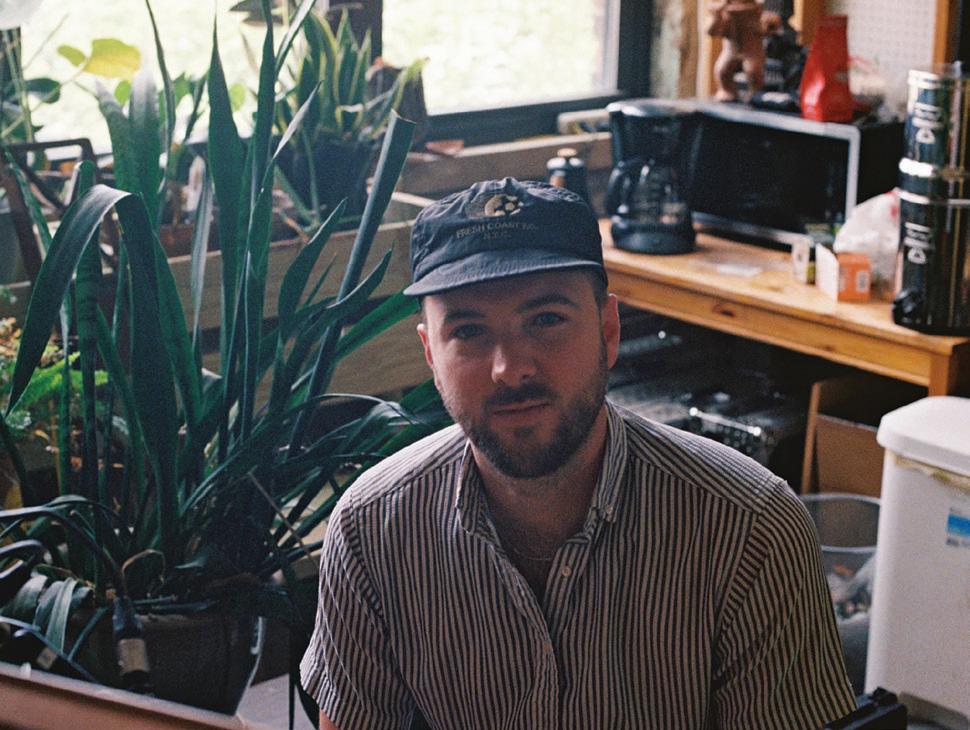
FRIDAY24
Electric Citizen Earth Tongue and Satin Banshee open. 8:30 PM, Reggies Music Joint, 2105 S. State, $27.24, $22.93 in advance. 21+
Electric Citizen is the brainchild of guitarist Ross Dolan and singer Laura Dolan, high school sweethearts who married and formed their dream band. The 70s-inspired psychedelic metal of the Cincinnati rockers’ 2014 debut, Sateen , worships shamelessly at the altar of Black Sabbath, Pentagram, and their ilk—especially Laura’s vocals, which took cues from Bobby Liebling. The 2010s had more than their share of retro-leaning occult rock and metal groups, and because many seemed more concerned with fashion than function, Electric Citizen’s straightforward style stood out.
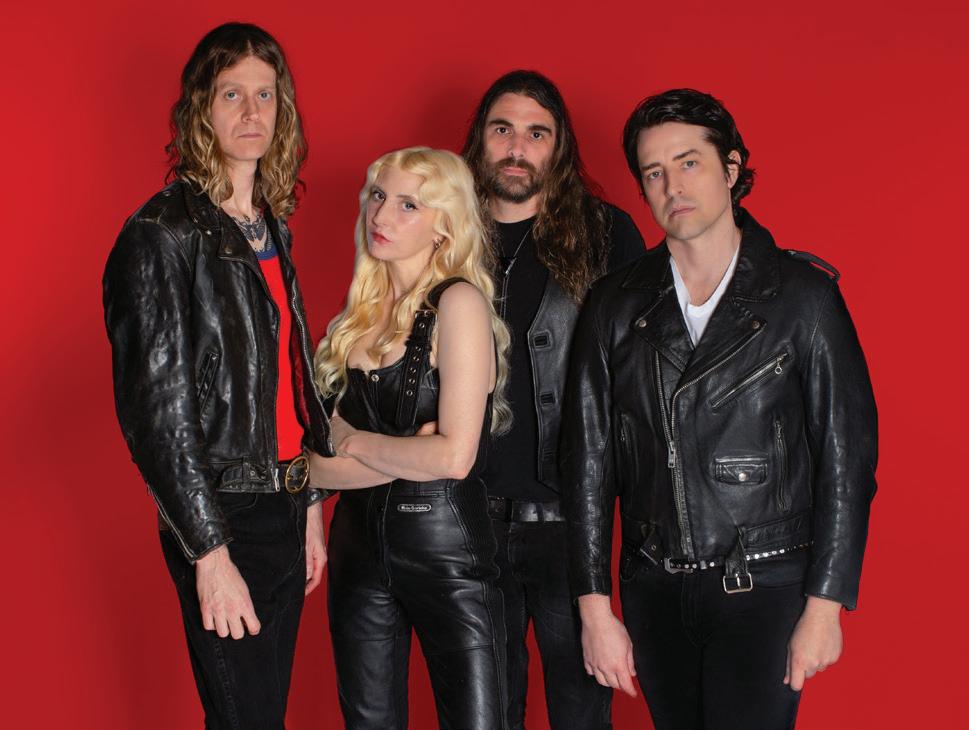
Electric Citizen’s psychedelia-soaked fourth album, June’s EC4 (Heavy Psych Sounds), also carries the sound and spirit of the 70s, but it also represents a major progression. Its songwriting and arrangements are more lavish, incorporating prog, glam, traditional metal, and more. Classic acts such as Deep Purple and Uriah Heep provide obvious touchstones, but the record feels less snugly tied to Electric Citizen’s influences and more interested in carving out an individual aesthetic. The core four-piece hasn’t changed, but this is their first album with keyboardist Owen Lee, who’s also a double bassist with the Cincinnati Symphony Orchestra and thus doesn’t tend to travel with the band. (He pitches in on songwriting, though, and you can hear his bass on EC4 track “Tuning Tree.”) Lee’s warm, spacious keys on “Static Vision” create a sanctified- sounding backdrop for Laura’s voice, which floats in and out like a sunbeam occluded by clouds. He enhances the next track, the raging “Smokey,” with fiendish, melodramatic arpeggios that enhance the tune’s delightfully devilish quality. Though that spirit recurs
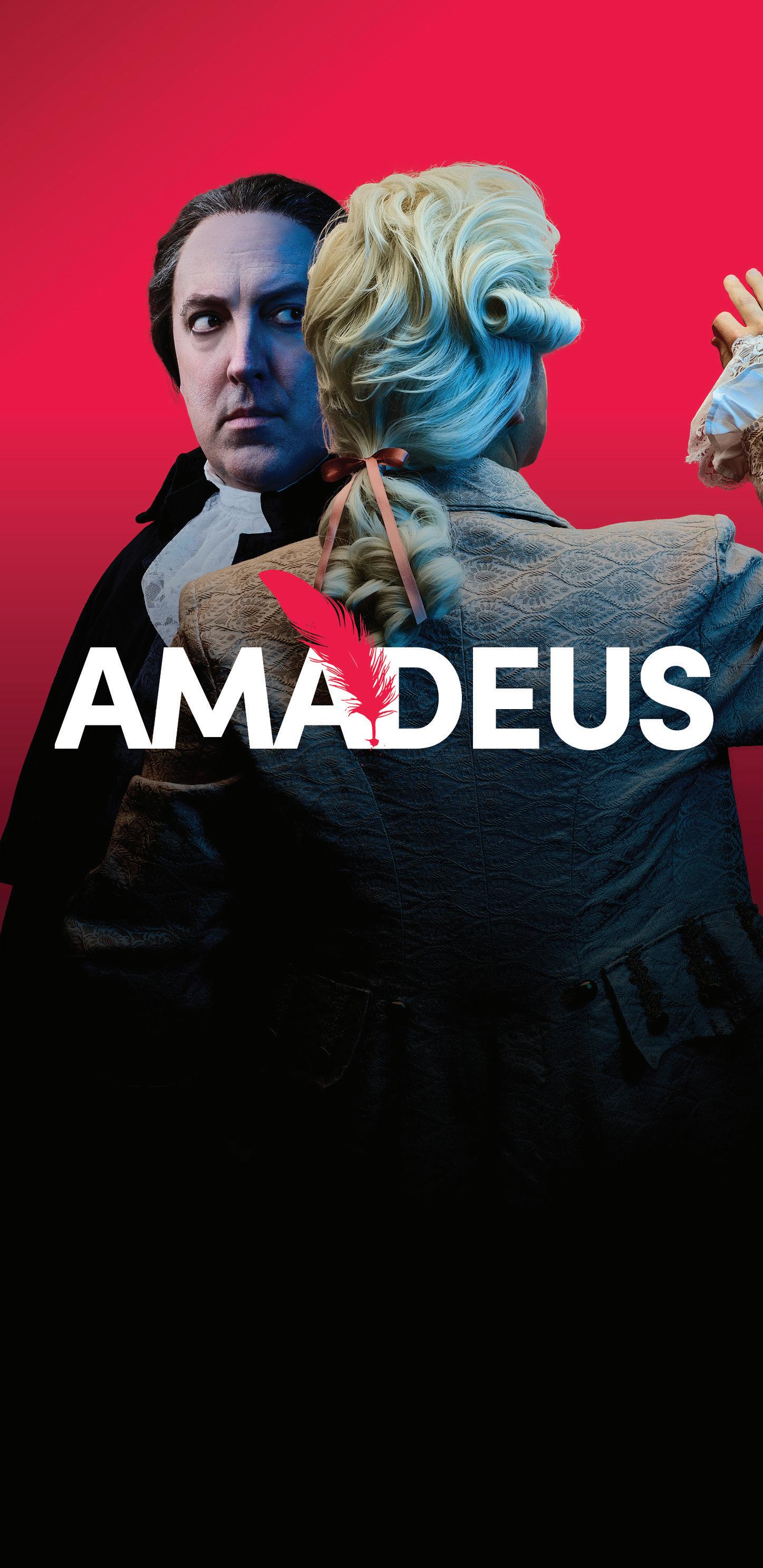
Let’s Play!
MUSIC

continued from p. 23
in the record’s second half (notably on “Lizard Brain”), it mostly settles into a somber mood, closing with the hazy, contemplative “Flower of Salt.”
—JAMIE LUDWIG
SUNDAY26
G Herbo See Pick of the Week on page 22. G Herbo Swerv & Friends First Annual Birthday Bash featuring G Herbo, A Boogie Wit da Hoodie, 21 Savage, Polo G, Meek Mill, 42 Dugg, Nardo Wick, Skilla Baby, Hunxho, Queen Key, and YK Niece. 7 PM, Wintrust Arena, 200 E. Cermak, $133–$351.50. b
TUESDAY28
Pink Siifu 8 PM, Subterranean, 2011 W. North, $33.14. 17+
Alabama-born rapper Pink Siifu takes a loose, fluid approach to lots of things—including his musical style and the general idea of authorship. In January he dropped the album Black’!Antique, and it’s sometimes frenetic, sometimes lackadaisically smooth; it’s also nominally a solo project, but its wild, anything-goes energy arises directly from a fascinating array of more than two dozen cowriters and collaborators. “Facecard’!,” for example, lists five contributors, and its jittery percussion and dreamy synths make it sound like the work of the credited producers, Detroit ghettotech group HiTech. Black’!Antique is Siifu’s fourth studio album, and though it’s technically his first since 2021’s Gumbo’! , he’s kept busy recording and releasing material with his friends, including two great 2023 records: the R&B-heavy Leather Blvd (made with California producer Ahwlee as the duo B. Cool-Aid) and the freewheeling It’s Too Quiet..’!! (recorded with Cincinnati rapper Turich Benjy). “Together
Find more music listings at chicagoreader.com/musicreviews
we’re all trying to create this community and bring that Soulquarians or Dungeon Family energy back,” Siifu told Crack magazine in 2022. “I liked when you had everyone in the studio, from Badu to Common, D’Angelo and Dilla, all creating as one and feeding off one another.” Siifu has built that kind of ecosystem with this friends, and Black’!Antique proves how much vitality he can draw from it.
—LEOR GALIL
WEDNESDAY29
Lexa Gates 7 PM, the Promontory, 5311 S. Lake Park West, sold out, wait list $30.39. b
Born Ivanna Alexandra Martinez, singer and rapper Lexa Gates was raised in Puerto Rico and in Queens, New York, where she struggled in high school and dropped out at age 15. She’d felt overlooked and diminished by the public education system, and she spent the next couple years aimless, doing a lot of partying with friends. In her late teens, though, a breakup inspired Gates to return to a childhood interest in music, which grew into a passion. She started uploading her DIY tracks to Soundcloud in 2019, attracting attention with eclectic fusions of hip-hop, R&B, and jazz, which she accompanies with straightforward lyrics that mix dry wit, real talk, and self-owns. On “Thinking of You,” from last year’s Elite Vessel, Gates raps about a toxic roller coaster of attraction, ambivalence, and fear of commitment over a simmering 90s-flecked R&B groove. “I’m bad with things that involve anyone other than me,” she confesses to the object of her desire. “But I’ve been tryna be / Somebody that your sister could look up to.”
Last month, Gates announced a new album, I Am, to be released later this year. The first single, “Nothing to Worry About,” mixes dreamy retro soul with Gates’s verses about the grind of a full-time artist pursuing financial and creative independence. Despite her streetwise cynicism, she’s got plenty of dreams—along with the drive to make them reality.
—JAMIE LUDWIG
v

SEX AND RELATIONSHIPS
Love & leashes
Exploring the different parts of yourself
By DAN SAVAGE
Q: Flashback: My last serious girlfriend was kinky. I am pretty vanilla—I’m not a natural sub—but I was game. We got into D/s play, and we went to some big fetish parties together. Her favorite “foreplay” was having me kneel between her legs while she showed me guys on dating apps she’d matched with and make me beg for her pussy. I was never into cuck stuff, but I have to admit that was hot (and obviously cuckadjacent). Her fantasies weren’t my fantasies, but it turned her on so much it turned me on. And these really were her fantasies: She had an alt Twitter account since she was a teenager that was all FemDom content and pictures of tied up guys. We wound up breaking up for reasons that had nothing to do with our sex life or her kinks. We don’t live in the same city anymore, but we still follow each other on Instagram and DM on birthdays. Nothing inappropriate. We were together for three years and it’s been five years since our breakup.
Flash-forward: My current serious girlfriend dug through my ex’s Instagram account and found pictures of us at fetish parties. She didn’t snoop on my phone— which means she didn’t read my DMs (thank god)—but she did scroll through hundreds of old posts on my
reader, VBKP, you knew that was coming. And since you knew I was gonna tell you to do that, I suspect being told to do that was what you wanted. (Are you sure you’re not a natural sub?)
ex-girlfriend’s account. She wound up finding pics of me in bondage and being dragged around by my ex on a leash at a few parties. (Was that snooping?) Now my girlfriend says she wants to “get into” my kinks. I told her that the things she was seeing in those old pics weren’t my kinks. It was fun; I got into it because my ex was into it, but being dominated isn’t something I need. I would be down to explore it (or anything else) with my current girlfriend if it felt like it was coming from an honest place, but it feels like she’s in some weird competition with my ex. We’ve been together for two years and she can be insecure and now she’s worried I’m bored with our sex life and I’m going to break up with her for someone kinkier. The fact that I “refuse” to do kink with her is becoming a thing. But this feels fake to me, since she never mentioned kink until she saw those pics (which my ex took down when I asked), but my girlfriend claims she is interested in kink even if she only realized it when she saw those photos. I’m not sure what my question is or what I want you to tell me to do.
—VANILLA
BOY KINKY PAST
a: I’m always gonna err on the side of telling a straight boy to get down on his knees and beg his girlfriend for her pussy—so, if you’re a regular
Zooming out: You could leverage this moment— brought to you by the notquite-snooping-but-close your current girlfriend was doing—to have a conversation about your authentic kinks and your hardwired sexual interests (which you don’t list) and your current girlfriend’s authentic kinks and her hardwired sexual interests (which you also don’t list). If you’re both interested in more than just the vanilla sex, or your girlfriend is interested in trying new things, now would be a great time to compare your lists of nonvanilla sexual interests to see if there’s any overlap.
Dominant women are rare— that’s why dominant women can charge for it while dominant men have to give it away for free. Your odds then of dating two “naturally” dominant women in a row are pretty slim. But they’re not zero. So, while your ex-girlfriend seems to have been consciously aware of her kinks from an early age—as her long-running alt Twitter would seem to prove—it’s entirely possible seeing those pics of you at a fetish party made your girlfriend aware of her kinks for the first time. Not everyone with kinks and/ or in the kink scene was consciously aware of their kinks at 13; that’s especially true of cis women, who tend to become aware of their kinks in adulthood whereas cis men tend to become aware of them in adolescence. So, I think you need to allow for the possibility that your girlfriend’s sudden interest in D/s play is just as authentic as your ex-girlfriend’s long-standing interest in D/s play, VBKP, and seeing those old pics of you was the inciting/exciting incident that
brought your girlfriend’s into focus. And even if it turns out your girlfriend is just going through the motions for silly reasons (and competing with someone you dumped five years ago would be very silly), what’s the harm? If she doesn’t enjoy it, VBKP, or you don’t enjoy it—if D/s play doesn’t work for you and the current the way it worked for you and the ex—you don’t have to keep doing it.
P.S. I would hate to be in a relationship with someone who would freak out if they stumbled over evidence that I’d sent a nice note to an ex on his birthday.
Q : I’m a 52-year-old bisexual man married to a lovely lady who’s five years older than I am. I feel like my soul (super melodramatic here) is shriveling up and dying. I’m sick of monogamy, sick of comfortable missionaryposition sex once a week, and I’m really sick of the subtle bi-shaming comments like, “That’s the gayest shirt I’ve ever seen.” She’s trying to be better, she really is, but navigating our divergent needs in our 12-year relationship is leading to communication breakdowns. Making matters worse, I have this awful habit of bringing difficult stuff up when I’m stoned—pot helps with my inhibitions (it also helps me sleep, so I’m stoned pretty much daily)—but she
hates talking to me when I’m stoned. But everything is so fraught when it comes to my needs that I can’t talk about it when I’m not stoned. Basically, I’m tired of missionary-position sex once a week, and I would like to wear a gay T-shirt once in a while without being judged or shamed. I feel like I’m being hollowed out. Anyhow, I need to figure out a fun non-stoned way to discuss without the conversation ending in tears.
—H
IGH
ISN’T GONNA HELP
a: It’s the dick, right? You miss the dick? And the lack of dick in your life—other than your own—has you feeling unfulfilled? And does your wife sense that? Or does she know it, HIGH, because you blurt it when you’re high? And you’re high every night? And could her anxiety about you wanting to open the relationship for dick be why she’s making biand gay-shaming comments about your T-shirts?
If you can’t talk about your needs when you’re not high and your wife doesn’t want to talk to you when you are high—could be true or could be an excuse to avoid the conversation—your best bet is a couples counselor. You won’t be high (or shouldn’t be high) when you’re sitting on that couch in the middle of the day, HIGH, and you won’t be able to avoid—a
good counselor won’t allow you to avoid—the conversation you made the appointment to have.
But first you’ve got to figure out what you actually want. Would you feel fulfilled if you and your wife had more and better sex—not once-a-week missionary, but something freer and queerer? (Is the wife willing to peg you?) Or do you need the freedom to have sex with other men? If it’s the first thing, say that: you love her, but you need more variety. If it’s the second thing, say that too—and that’s a hard thing to say, I realize, and an even harder thing to hear . . . so, yeah. It’s a conversation that may result in tears, but those kinds of conversations, as difficult as they are, rarely end in tears. Eventually, you have stop crying and start talking again. And that’s when the real work—and the real negotiations—can begin.
P.S. For the record: bisexual people can make and honor monogamous commitments. HIGH has, up to now, honored the monogamous commitment he made to Mrs. HIGH. Monogamy isn’t for everybody—gay, straight, bi, pan, omni, whatever—and it’s not always forever. v
Ask your burning questions, download podcasts, read full column archives, and more at the URL savage.love. m mailbox@savage.love

Sign
GOSSIP WOLF
INDIE-ROCK BAND CUSP made their live debut in Rochester, New York, the city where they got together, just before the COVID pandemic. “We really weren’t sure what our futures held for us in Rochester,” says singer and guitarist Jen Bender . “The pandemic was devastating—particularly for a city that was very reliant on DIY venues for our kind of music. We didn’t know the way forward there. We had a discussion as a group, like, ‘Where do we go from here?’”
Cusp looked to Chicago, and they moved here in summer 2022. They’ve since become one of the city’s best indie groups of the decade—and if they hadn’t relocated, they may not have finished their brand-new second album, What I Want Doesn’t Want Me Back
Cusp’s original four- person lineup split during the band’s move. Drummer Dylan Vaisey and bassist Cassidy Rose Hammond went to Philadelphia instead, where they launched their cult shoegaze group, Full Body 2. Bender and her partner, guitarist Gaelen Bates , recruited Matt Manes to join Cusp and move from Rochester to Chicago with them. They also persuaded him to switch axes. “He’s not a bass player by trade,” Bender says. “He’s a really good guitar player. I said, ‘You’re gonna play this other instrument.’ He’s been very good at it—and gracious to do that.”
The band released their 2023 breakthrough album, You Can Do It All, about a year a er arriving in Chicago. They recorded each instrument separately and used a couple different drummers. Bender also recruited drummer Tommy Moore and keyboardist Tessa O’Connell to play in Cusp, though neither appears on You Can Do It All. Bender had met them through Chicago-based music-gear marketplace Reverb, which had hired her just before she moved here. What I Want Doesn’t Want Me Back is the first Cusp record with the current five-member lineup: Bender, Bates, Manes, Moore, and O’Connell.
A furry ear to the ground of the local
music scene
in a twangy direction that when the band hit the studio they brought in local folk and country sideman Andy “Red” PK to guest on pedal steel. “That song started as a demo I had submitted to a compilation a long time ago,” Bender says. “It took on this life and became an actual Cusp country song, which will probably never happen again. I’m glad it did.”
Jersey City indie label Exploding in Sound put out What I Want Doesn’t Want Me Back last week. To celebrate the release, Cusp headline Lincoln Hall on Saturday, October 25. Tenci and Pictoria Vark open; tickets cost $27, and the show starts at 8 PM.

grassroots hip-hop party he threw at Club Lower Links in the early 90s, which helped shape the local scene into something coherent. No venue elsewhere in the city has duplicated the Promontory’s dedication to local dance, R&B, hip-hop, and jazz, and that’s due in no small part to the staff that helped shape its identity— Reader contributor Jake Austen played a critical role as the venue’s talent

THE PROMONTORY in Hyde Park opened its venue in August 2014 with a set by “Tom Tom” Washington’s South Side Big Band Sadly, at the end of the year, it will close down—the venue shared an official announcement on Instagram on Monday, October 13. The second-floor venue has hosted plenty of big-name touring acts, including Maceo Parker , Kelela , and Tobe Nwigwe , and it’s really shined as a hub for homegrown Chicago culture.
CLASSIFIEDS JOBS SERVICES MATCHES

JOBS
Accurate Group, Inc. seeks Civil Engineers for Lincolnshire, IL location to be responsible for assisting in the planning & designing of building structures & facilities. Bachelor’s in Civil Eng/ Construction Eng/related field +2yrs exp req’d. Req’d Skills: AutoCAD, e-builder, CDOT CMQA, Quantity Surveying/ Estimation, Construction Project Scheduling, Billing, Estimating, Planning, & Execution. 50% travel to various and unanticipated project sites as required. $90,875-95,000/yr. Send resume to: A. Ramos, hr@accgi.com, REF: SBM
Senior Consultant, Software Engineers sought by Focused Labs Inc., Chicago, IL, to collaborate w/ stakeholders to dsgn, query, & maintain relational & NoSQL d/bases, etc. Deg’d applicants exp’d w/ react.native, Vue, Swift, Java, SpringBoot, Kotlin, etc. Benefits incl sick & vacation pay. Salary range: $148,949.00$149,000.00/yr. May telecommute. Reqs 10% travel nationally, incl the Midwestern & Western United States, to meet w/ clients on projects. Send resume to recruiting@ focusedlabs.io.
“We played the record together, in a room together, at Electrical [Audio],” Bender says. “We captured it in the moment instead of doing it in that more staggered way, which has its challenges—and also has its tremendous benefits.” The five-piece lineup has also helped steer some of the material in directions Bender couldn’t have predicted. Most notably, they pushed “The Upper Hand” so far
Gossip Wolf fondly remembers the Promontory hosting one of the final performances by Association for the Advancement of Creative Musicians cofounder Kelan Phil Cohran on May 10, 2017, two days a er his 90th birthday and six weeks before his death. And in October 2023, the venue presented a show that doubled as Duro Wicks ’s 56th birthday celebration and tripled as a reunion for the
buyer for years. Keep your eyes peeled for farewell events come December.
LAST MONTH, ACCESS Contemporary
Music opened a venue called the CheckOut in a former 7-Eleven at 4116 N. Clark. If you’ve been looking for a novel way to get into the Halloween spirit this season, the CheckOut is providing an intriguing opportunity: On Sunday, October 26, it hosts a screening of Häxan, a 1922 silent quasi-documentary about witchcra , with a live original score by futuristic alt-pop project Ferrn . The screening is presented by Tesseract Cinema, an itinerant alternative film collective that plans to open its own physical theater in Pilsen next year. The performance starts at 7 PM; tickets cost $24.11. —LEOR GALIL
Got a tip? Email your Chicago music news to gossipwolf@chicagoreader.com.
Insight2Profit seeks a Business Development Manager in Chicago, IL, to identify and set account strategy and develop sales opportunities within target industries (particularly for private equity-backed portfolio companies) via opportunity pursuit, relationship development, and project and process management. Requires minimum bachelor’s degree in a management or business discipline or closely related field (or its foreign equivalent), at least 3 and [HEX:bd] years of experience in a professional services environment conducting pricing-related work, including pricing strategy and analytics, and demonstrable financial, market, and strategic business acumen via successful completion of an industry case study. Requires 3 ‘in office’ days per week when not travelling. Travel is nationally to client locations up to 50 % of the time. Send resumes to Alyssa Pazdan, 125 S Wacker Dr, Ste 1300 , Chicago, IL 60606.
Lead Principal Medical Safety Analyst (Vendor Management), AbbVie Inc., North Chicago, IL. (100% telecommuting permitted). Support case processing organization to achieve its mission of improving patient lives globally through consistent and accurate delivery of high quality, relevant, and timely adverse event management by providing effective oversight of external providers of Pharmacovigilance services for AbbVie. Conduct oversight of vendors to ensure collection, assessment, and processing of adverse event information (clinical and post marketing) is performed in a compliant and timely manner to comply with global regulations and to ensure company standards for quality, compliance and productivity are met. Must have a Bachelor’s in Pharmacy, Nursing or related Life Science field & 4 years of experience with each of the following: Conducting drug safety Pharmacovigilance in a pharmaceutical or related industry; Leading project work and teams in Pharmacovigilance; Managing case processing processes, procedures, and conventions; and Applying knowledge of industry regulations (ICH, FDA, EMEA, MHRA). Work experience may be gained concurrently.Salary Range: $127,822.50 - $178,500.00 per year. Apply online at https://careers.abbvie. com/en or send resume to Job.opportunity.abbvie@ abbvie.com. Refer to Req ID: REF45371F.
Information ResearchTest Automation Lead, AbbVie Inc., North Chicago, IL. Hybrid (onsite 3 days a week/ 2 days WFH/remote). Lead test automation for Information Research Business Applications, ensuring systems are automated & scalable for business needs while enhancing user experience. Provide strategic direction & oversight for test automation developers. Collaborate with teams to build robust automation roadmaps & supports projects. Lead design & development of test suites & data processes. Coordinate UATs with stakeholders to validate automation. Advise on improvements & ensure compliance while resolving issues & providing training. Develop metrics to evaluate quality, facilitating data-driven decisions for continuous improvement. Must have a Bachelor’s Degree in Computer Science, Engineering, or related discipline or foreign education equivalent, & 5 years of performing System Testing, Test Automation, Data Integrity, & Data Transformation. Of experience required, must have 5 years with
each of the following: (i) managing multiple projects, collaborating with project teams, interfacing with clients, & deploying technology to build successful solutions for scientists & business stakeholders; (ii) working cross functionally with business stakeholders & technical project teams to develop an automation approach to address business needs & presenting, in writing & orally , solutions to the business; (iii) validating, testing & building automation frameworks for enterprise multi-tier applications including: COTS, AWS Cloud, Custom Development & SaaS; & (iv) leading large multi part project initiatives, from initiation to delivery, with crossfunctional global teams. Must have 2 years with each of the following: (i) developing test automation scripts using Tosca, Jira, & qTest; (ii) performing data & system testing using Waterfall, Agile & DevOps methodologies; & (iii) performing queries using Oracle, SQL & MySQL. Work experience may be gained concurrently. Salary Range: $143,442.56 - $178,500.00 per year. Apply online at https:// careers.abbvie.com/en or send resume to Job. opportunity.abbvie@ abbvie.com. Refer to Req ID: REF45367Q.
Project Lead & Multiple SW Developers Needed Project Lead needed to analyze requirements & communicate with key stakeholders to determine project objectives, analysis, design, development, integration, & system testing. Duties will be performed using Oracle Demand Planning, Oracle VCP Supply Planning Applications, & Oracle Demantra. The wage offered is $150,000/ Yr. Multiple Software Developers needed to dvlp, create, & modify comp app software or specialized utility programs. Analyze user needs & dvlp software solutions. Multiple positions are available for Software Developers using one of the listed combinations of tools or skills. SWD position 1 -duties will be performed using Java, webMethods, & MuleSoft; SWD position 2 - duties will be performed using ASP. Net, Azure, & SQL Server; SWD position 3 - duties will be performed using webMethods, RESTFull services, & RDBMSOracle; SWD position 4 - duties will be performed using Web Services, ASP. Net, & C#; SWD position 5 - duties will be performed using AWS, Node.JS, & JavaScript; SWD position 6 - duties will be performed using ServiceNow, BMC Remedy, & ITSM; SWD position 7 - duties will be performed using AWS, Node JS, & Postgresql;
SWD position 8 - duties will be performed using Google Dialogflow, Genesys Cloud, & MERN Stack (Mongo, Express JS, React JS, & Node JS). Offered wages for SWD positions 1 to 5 is $153,317.00/yr. Offered wage for SWD position 6 & 7 is $130,707.00/yr. Offered wage for SWD position 8 is $160,000.00/ yr. Not all positions require all skills & tools. Work locations for all positions will include Chicago, IL & also at various unanticipated locations in the U.S., as assigned, which may require relocation. Applicants should clearly identify the position they are applying for in their cover letter. The resume must specifically list all post- secondary education, training, or experience. Resumes must show if the applicant has any of the mentioned combination of tools or skills. Mail all resumes to Quinnox, Inc., Attn: EVP & Head - Immigrations, 1 South Wacker Drive, Ste # 3150, Chicago, IL 60606.
Senior Business Systems Analyst (R&D Quality Assurance), AbbVie Inc., North Chicago, Illinois. Hybrid - 3 days onsite/2 WFH. Consult with the R&D Quality Assurance functional area to develop understanding of complex business needs supported by enterprise quality management systems. Determine how changing Quality Assurance business needs will affect the system. Understand the role of the system in the big picture & provide ideas & recommendations regarding the evolution of the system. Respond to questions & influences the users regarding current & potential Quality Assurance system inputs, processes, & outputs. Conduct research & analysis into the nature, effect, & results of system problems. Develop detailed business user requirements, system documentation, workflow procedures, & data modeling. Review & route requested system changes & develop detailed specifications for implementation. Communicate system changes & propose issue resolutions to the next level of management. Ensure current & accurate system documentation, coordinate &/or perform testing of system modifications, both validated & nonvalidated systems. Must have a Bachelor’s degree in computer science, information systems, engineering or similar STEM related field; & 5 years of application &/ or computer systems development experience. Of experience required, must have at least 5 years of work experience in each of the following: (i) systems development, implementation, & operation of large-scale
IT solutions; (ii) working independently within a matrixed corporate environment synthesizing stakeholder needs into technical solutions; (iii) proposing viable & efficient IT solutions by understanding business challenges & identifying available commercial & bespoke software solutions, & (iv) developing detailed business user requirements, system documentation, workflow procedures, & data modeling. Candidate must provide examples of same. Alternatively, would accept Master’s degree in computer science, information systems, engineering or similar STEM related field; & 2 years of application &/ or computer systems development experience. Of experience required, must have 2 years of (i), (ii), (iii) & (iv). Work experience may be gained concurrently. Any suitable combination of education, training & work experience accepted. Salary Range: $117,957.00 - $122,000.00 per year. Apply online at https://careers.abbvie. com/en or send resume to Job.opportunity.abbvie@ abbvie.com. Refer to Req ID: REF45368F.
Senior Scientist II, Process Chemistry, AbbVie Inc., North Chicago, IL. Conduct chemical process research and development, supporting projects from pre-clinical stages through commercialization. Act as a lead scientist in his/her in the area of organometallic chemistry to conceive & execute novel scientific research or development that achieves projects and area goals. Conduct High Throughput Experimentation (HTE) to critically evaluate relevant development programs. Contribute to the development of machine learning models applied to organometallic chemistry. Must have a MS in Chemistry or foreign educational equivalent, & 3 years of academic &/or industry experience as an organometallic scientist. Of experience required, must have 3 years of each of the following: (i) utilizing high-throughput experimentation (HTE) techniques & instrumentation; (ii) performing synthesis using organometallic transformations, preparing metal complexes & their structural elucidation; & (iii) contributing to machine learning model development using chemical descriptors. Alternatively, PhD in Chemistry or foreign educational equivalent, & 1 year of academic &/ or industry experience as an organometallic scientist. Of experience required, must have 1 year of each of the following: (i) utilizing high-throughput experimentation (HTE) techniques &
instrumentation; (ii) performing synthesis using organometallic transformations, preparing metal complexes & their structural elucidation; & (iii) contributing to machine learning model development using chemical descriptors. Experience may be gained concurrently. Any suitable combination of education, training & work experience accepted.Salary Range: $131,124.15 - $178,500.00 per year. Apply online at https://careers.abbvie. com/en or send resume to Job.opportunity.abbvie@ abbvie.com. Refer to Req ID: REF45370V.
Sr. Manager, BI Analytics (Aesthetics), AbbVie US LLC, North Chicago, IL. 100% Telecommuting permitted. Partner with fellow leader stakeholders to structure and answer analytical questions critical to the success of our business. Lead and manage analysts who design innovative analytic approaches to implement actionable insights thru identifying patterns in structured & unstructured data. Be instrumental in leading the use of analytics as a critical value driver across our organization. Shape the thinking of teams by communicating the details of their teams’ analyses & business implications. Lead analysts who develop dashboards to enable clear visibility into business performance. Work with data engineering leadership to ensure accurate & up-to-date data power each analysis. Must have a Bachelor’s degree in Mathematics, Statistics, Operations Research, Computer Science, Business Intelligence/ Analytics or foreign educational equivalent & 5 years of work experience driving business decisions with data-driven analyses. Of experience required, must have 3 years leading analysts in each of the following: (i) deciphering & generating complex SQL queries using window functions, CTEs & aggregate functions; (ii) generating business insights using Tableau or PowerBI; (iii) mining, validating & structuring disparate datasets within the big data eco-system for BI engineering production development; (iv) applying statistical analyses, experiment design, regression & modeling to business problems; (v) translating data results in a nontechnical format for written & oral presentations to business stakeholders); & (vi) working in a matrixed organization working across business stakeholders and line functions to gather, analyze synthesize requirements and translate. Work experience may be gained concurrently. Salary Range: $165,520.05 -
$202,500.00 per year. Apply online at https:// careers.abbvie.com/en or send resume to Job. opportunity.abbvie@ abbvie.com. Refer to Req ID: REF45369H. Hireology, Inc seeks an Lead Software Engineer in Chicago, IL to design, develop, and implement software systems utilizing server-side frameworks. Req. MS + 3 yrs exp. in the position offered, or as Sr. or Lead Software Engineer. Salary: $191,400/yr. 100% telecommute; reports to HQ in Chicago, IL. Can work remotely or telecommute. Standard company benefits available. Apply online: https://hireology.com/ careers/ . Must ref. job title
The Office of Planning, Sustainability, & Project Management, at the Univ of IL Chicago, located in a large metropolitan area, is seeking full-time Assistant Director for Project Management, to assist the department with the following responsibilities: Under direction & supervision, write policies on topics governing construction & renovation of campus physical assets; In scope of architecture, engineering, & planning projects of University structures, serve as Owner’s Representative & provide professional support for all phases of a project, including planning, directingassigning, feasibility, design, construction document preparation, bidding construction & post construction; Interact w/ diverse group of clients, design teams, contractors & external regulatory agencies; Utilize specialized knowledge of three-dimensional CAD software & healthcare & research laboratory design & construction practices to perform project mgmt tasks; Exercise discretion & independent judgment to lead all aspects of project mgmt, including architect/engineer (A/E) team-building, scopeof-work & contract development, contract execution & dispute resolution; Help write & administer contracts w/ outside (A/E) consultants & contractors; Perform other related duties & Univ service as assigned & applicable. Some weekly travel may be required to our regional campuses in Rockford and/or Peoria IL. This position minimally requires a Bachelor’s degree or its foreign equivalent in Architecture, Engineering, Construction Management, or related field. For fullest consideration, please submit CV, cover letter, and 3 professional references by [11/21/2025] to Deborah Brooks, Office of Planning, Sustainability & Project Management, University of IL Chicago,
1140 S. Paulina Street, 210 PSB, M/C 892, Chicago, IL 60612 or via email to dbrooks@uic. edu. The salary range for this position is $100,000 to $130,000. For a complete list of Employee benefits, visit https:// www.hr.uillinois.edu/ benefits. The University of Illinois at Chicago is an affirmative action, equal opportunity employer. All qualified applicants will receive consideration for employment without regard to race, color, religion, sex, gender identity, sexual orientation, national origin, protected veteran status, or status as an individual with a disability. The University of Illinois conducts background checks and other preemployment assessments on all job candidates upon acceptance of a contingent offer letter. Background checks will be performed in compliance with the Fair Credit Reporting Act. As a qualifying federal contractor, the University of Illinois System uses E-Verify to verify employment eligibility. The University of Illinois System requires candidates selected for hire to disclose any documented finding of sexual misconduct or sexual harassment and to authorize inquiries to current and former employers regarding findings of sexual misconduct or sexual harassment. For more information, visit https:// www.hr.uillinois.edu/cms/ One.aspx?portalId=4292 &pageId=1411899
Software Engineer(s) RedMane Technology LLC seeks Software Engineer(s) in Chicago, IL to design, develop and implement object-oriented n-tier software applications, including web-based applications, using Curam software. Hybrid work schedule. Rate of pay $153317 to $192500 per year. Email CV to yourcareer@redmane. com; reference job code D7038-00155. E.O.E.

SERVICES
CHESTNUT ORGANIZING AND CLEANING SERVICES: especially for people who need an organizing service because of depression, elderly, physical or mental challenges or other causes for your home’s clutter, disorganization, dysfunction, etc. We can organize for the downsizing of your current possessions to more easily move into a smaller home. With your help, we can help to organize your move. We can organize and clean for the deceased in lieu of having the bereaved needing to do the preparation to sell or rent the deceased’s home. We are absolutely not judgmental; we’ve seen and done “worse” than your job assignment. With your help, can we please help you? Chestnut Cleaning Service: 312-332-5575. www.ChestnutCleaning. com www. ChestnutCleaning.com

MATCHES
McDonald’s Winnetka - You asked if I’d been at Sherwin-Williams. I said no-wish I had been. Your smile melted me! Tell me what I was wearing and how I look. xiamin57@gmail.com
58 MWM seeking female counter part who would appreciare a decent, fun, ,male for an on-going FWB situation. Please be real, sane and open minded! skngcouple@yahoo.com


1 in every 20 print readers becomes a member.

